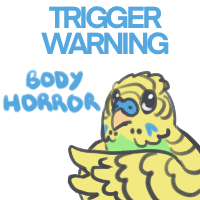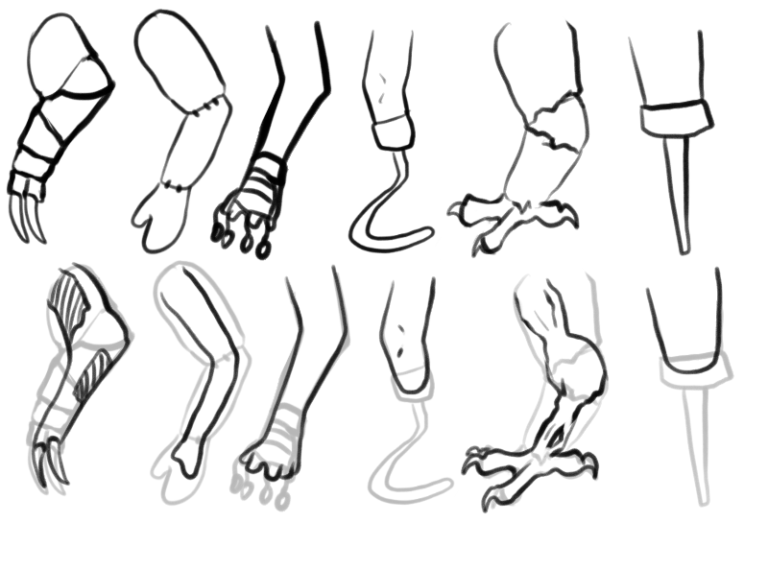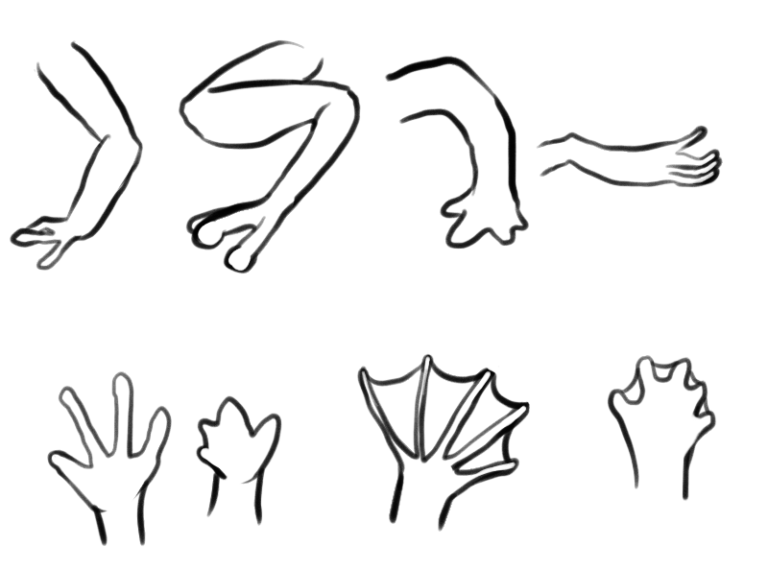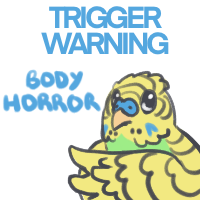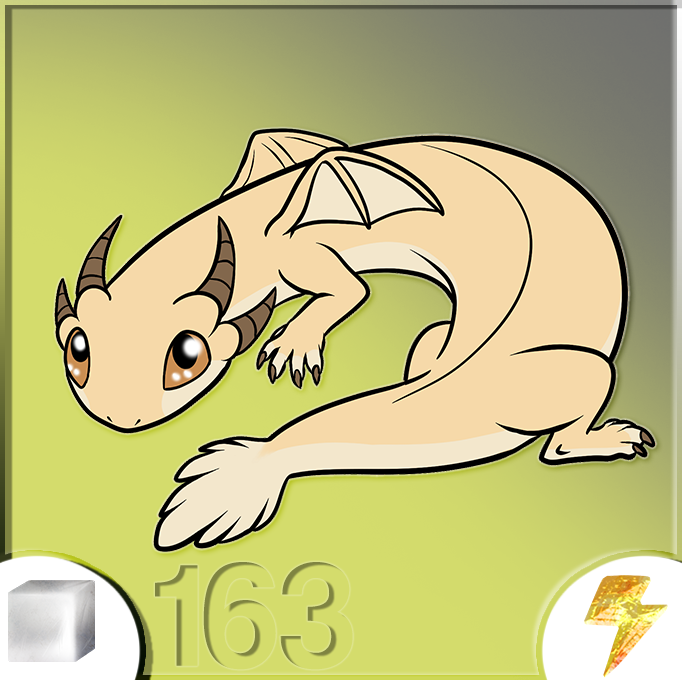Traits
Artificial Limbs
Legs should follow the body shape rules–the center of mass should be further forward for quadrupedal dragons and further back for bipedal dragons. The scales of all dragons may switch to smooth scales at some point between the shoulder and claws; if they do, it will match the color of anywhere else on the dragon with smooth scales. This smooth-scaled area may have a different color than the normal base, as long as it’s within elemental rules. If a dragon is already smooth-scaled, then it will all be one solid color.
Limbs which are made of metal, clay, or some other clearly manufactured/artificial substance. You may choose to have only one limb be artificial. If you do, the other limbs will resemble one of their parents or one of their natural element (excluding mythic limbs). They must be designed for grabbing, walking, or swimming, and movement functionality. It will not have an excess of materials, things hanging off of it, decorative designs, or frivolous add-ons. You may choose to draw your dragon without artificial parts, although there will be some sort of weakness or deformity underneath them.
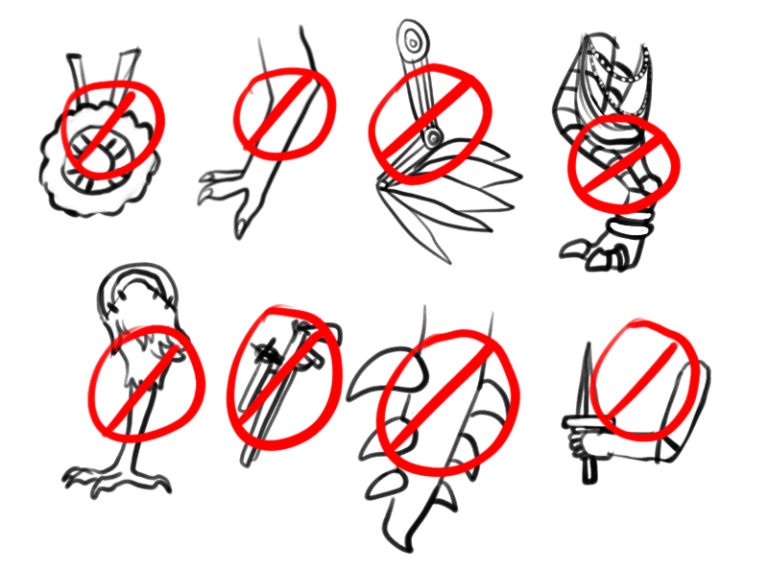
Issues with the above legs:
Row 1: 1 – not designed for grabbing, walking, or swimming; 2 – artificial traits are not apparent; 3 – not designed for grabbing, walking, or swimming–they look like wings; 4 – too many unnecessary objects that do not serve a practical purpose, along with too many materials
Row 2: 1 – fur is not an artificial material, and faux fur is also not accepted; 2 – this is a firearm, not an actual arm; 3 – this is not designed for grabbing, walking, or swimming; 4 – this has a feature which is not practical and likely not part of the limb itself
The following list has a few acceptable materials for artificial traits. Their colors must be at 90% opacity or more (see colors for more info on transparency and color). If you do not see something on this list, feel free to ask if it is available!
- Plastic
- Clay
- Metal
- Glass
- Cloth
- Wood
- Bone (note–must be carved/shaped rather than a skeleton on top of the dragon)
All traits must be visibly artificial in order to pass. In example, clay would have a few cracks or flakes, cloth would have something tying it to the rest of the dragon, and metal would have screws on the edges holding them together. You may use up to two materials. Each material must be the same color as all matching materials. In example, if you want to use brown clay as a material, then all other clay must match. Wires, screws, and simple fasteners do not count towards the material limit and may have their own color that matches something else on the dragon. The colors of these extras must still match each other.
Colors
Artificial traits will only have colors natural to their material or colors in the elemental spectrum. For example, a fire dragon cannot be covered in lime green metal. The natural colors of plastics are white and tan. The natural colors of cloth depend on the material used to make them; For that, stick to plant materials in our known universe. Cloth traits cannot be dyed without the Scalestain item. Glass will always be tinted white or an elemental color. Clay will take on white, gray, light steel blue, red, orange, brown, or tan colors, similar to the ones seen in the Earth palette.
As elemental creatures, the magic of your dragon may also color its features their corresponding elemental color, even if it is outside of that material’s natural range. In this situation, it will only be one or the other (a red clay + blue ocean element color can’t equal purple). The reason that glass will never be fully transparent is because of this ‘leaking’ magic effect.
Artificial traits may have a sheen/shine if it’s a material that naturally does that.
Display Traits
Similarly to color, a dragon’s display traits will always show, even if they need to leak through the artificial materials. While you can have artificial materials cover traits, they must still be apparent somewhere on the dragon. In example, if your dragon has Zebra, you may limit its stripes to the face and legs if your dragon’s body is covered in artificial scales. When the artificial parts are removed, you may have markings appear underneath, or simply leave that area blank.
What’s Underneath
The purpose of artificial traits is typically to aid in the health of the dragon. No dragon is born with their artificial traits included–their Rider, a passerby, or they themselves will construct something for them. Here are some reasons that a dragon may need artificial limbs: Malformed limbs, missing limbs, inability to walk, wants legs.
With that in mind, the traits underneath resemble traits you can see in other dragons. When your dragon has their artificial parts off, they will resemble a malformed version of a parent’s trait (with the exception of mythical traits, which will only produce a default option) or fingered limbs.
A Matter of Pride
Of course, there are many reasons that a dragon may not need artificial traits at all. There are crestless dragons that live their life just fine, wyrms that have no need of legs, and wingless critters that are content with their position on the ground. For dragons on the healthier scale of things--especially those of the Thunder element--artificial traits are a way to boost their confidence and have traits they believe is required for them, regardless of whether or not they really need that giant crown-shaped crest.
Going Without
Similar to healthy dragons which insist on their custom artificial traits, there may be some dragons with health issues that choose to go without. These dragons may choose to only partially cover their scales, replace only a single limb and leave the others mismatched, or even go without an aid entirely. If your dragon goes without, its design must follow the ‘What’s Underneath’ section above.
How do I make wolf feet/cat feet/[insert animal here]?
There are three ways to give your dragon paws. The first is to have mythic limbs, which allows lots of legs, different legs, and almost limitless possibilities for your limbs. The second method, and by far the easiest, is to have a dragon with fingered limbs. Lastly, there is the brawn trait. This rare Earth trait can give your dragon the feet of any land-based animal you can think of.
Can I make mis-matched legs?
If your feet are within the same type of leg (such as a sea turtle and a bird both being reptilian), then you may mix them without any extra stuff. Mythic limbs allow mis-matched legs. Brawn allows you to mix in pairs–which means the front can be bird-like, and the back can be paws–similar to a gryphon!
Feathered Scales
A coat of feathers that covers the dragon’s body. You may choose to leave the head and/or the legs bare, including just portions of them, free of feathers. They should not resemble thick fur or protofeathers. The feathers will have roughly the same length along the body. They will not form plumes or manes without the appropriate trait.
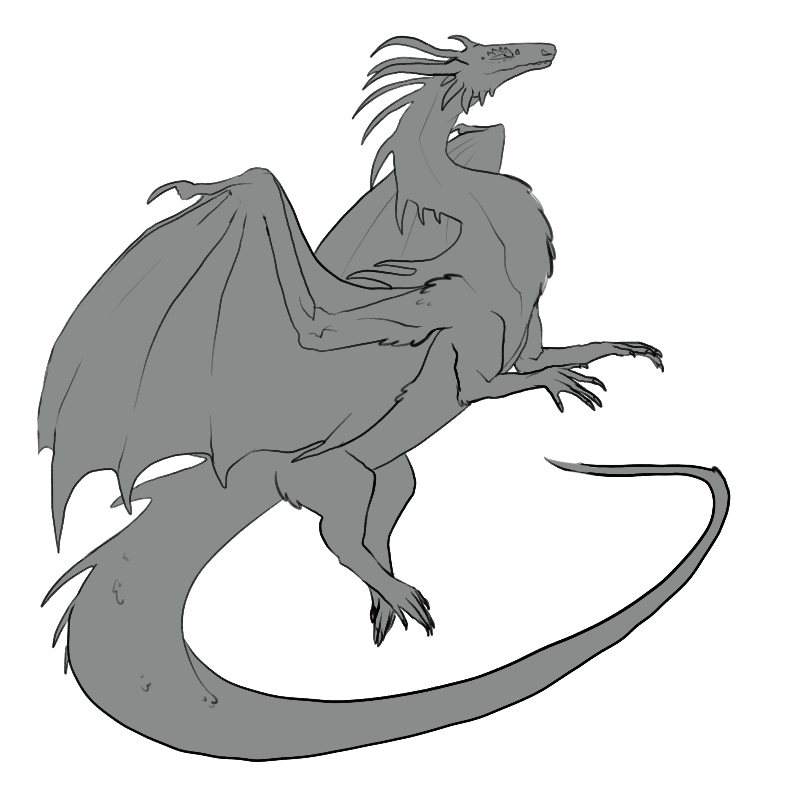
Feather and Fur Tips
The difference between feathers and fur can get very tricky with varying styles. Here is the general rule when drawing feathers. It will have the same flexibility as paper being pulled in the wind. This means paper makes for a very good reference in how feathers bend and fold. Feathers will generally move together and flow in the same direction, with the body. They will not wave in opposite directions or bend in more than one spot.
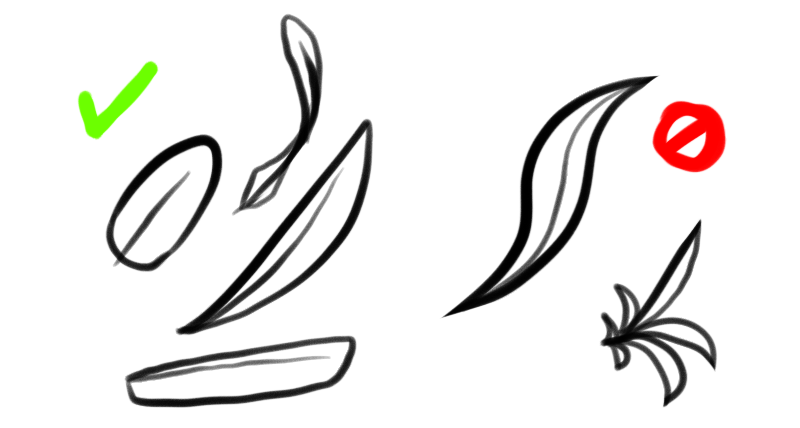
Common Interactions
- Accents - These affect the scales within the normal range.
- Skittertint - Skittertint does not affect base scales.
- Scalestain - Scalestain may create stylized feathers that bend in odd ways or resemble plumes/manes. The coverage is determined by the base of the feathers affected.
- Loremark - Loremark can remove scales where it touches. When long feathers are affected, only the base counts toward the coverage.
- Tattered - Tattered may cause feathered scales to show shredding or even have patches missing. Patches will be small, no bigger than the size of the dragon's head, and never affecting more than 1/6th of the dragon.
- Surgical Kit - Surgical Kit may remove feathered scales and reveal smooth skin underneath.
- Transparent Skin - Feathers will not grow on top of transparent skin. However, the edges might have feathers that extend a bit over the trait.
- Pollen - Pollen affects scales normally.
- Display - Display will not affect the base scales.
- Extensions - Extensions does not affect feathered scales. To create manes/plumes/similar structures, you will need to use Scalestains.
Smooth Scales
Silky smooth reptilian scales that do not protrude out from the body. Smooth scales will never appear shiny unless they have a Sheen trait or something similar.
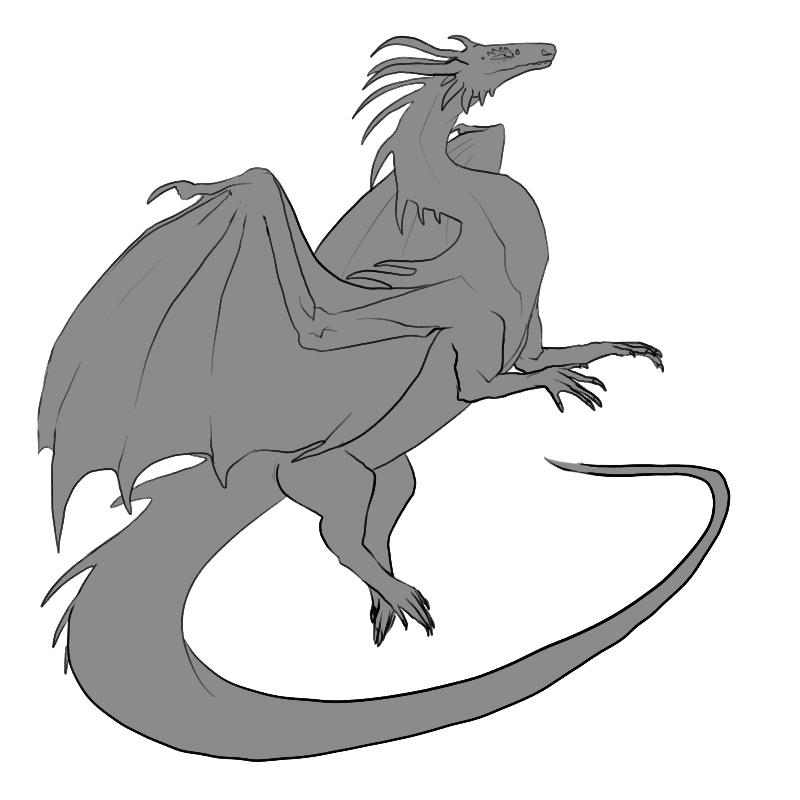
Common Interactions
- Accents - These affect the scales within the normal range.
- Skittertint - Skittertint does not affect base scales.
- Scalestain - Scalestain may create stylized scales.
- Loremark - Loremark can remove scales where it touches.
- Tattered - Tattered can create small scratches on the scales.
- Surgical Kit - Surgical Kit does not affect Smooth Scales.
- Transparent Skin - Scales will not grow on top of transparent skin. However, the edges might have scales that extend a bit over the trait.
- Pollen - Pollen affects scales normally.
- Display - Display will not affect the base scales.
- Extensions - Extensions does not affect scales. To create horns/spikes/similar structures, you will need to use Scalestains.
Velvet Scales
Short spines that resemble fur or velvet. They will never be longer than the fur of a horse. They will not have feathering/extra long hair on the legs unless they also have the Heraldry modifier. You may choose to leave the head and/or the legs bare, including just portions of them, free of scales. They should not create a mane without the appropriate trait. The scales will have roughly the same length along the body.
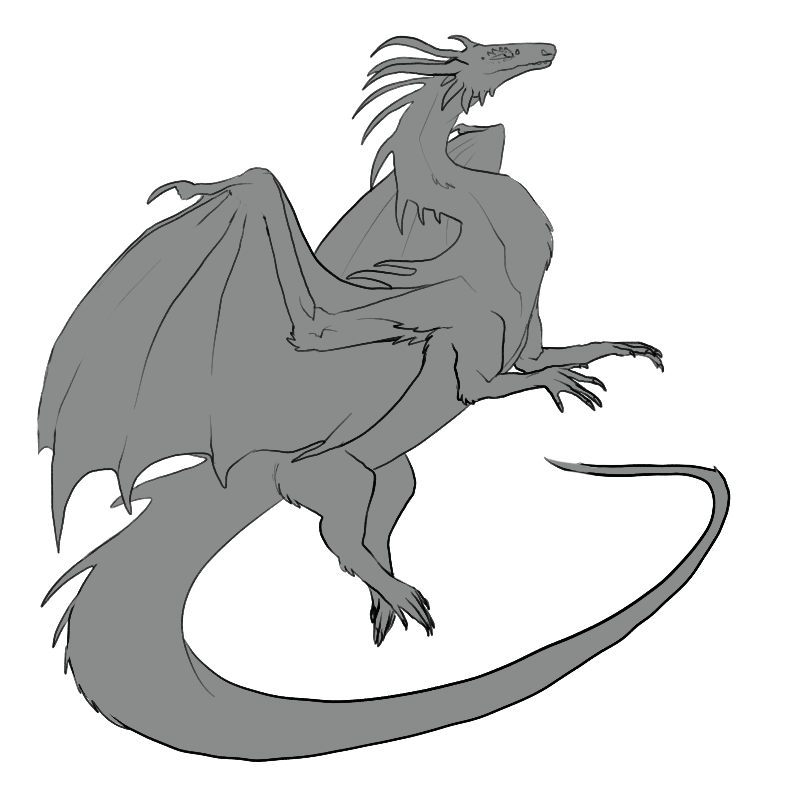
Common Interactions
- Accents - These affect the scales within the normal range.
- Skittertint - Skittertint does not affect base scales.
- Scalestain - Scalestain may create stylized fur that resemble tufts or manes. The coverage is determined by the base of the scales affected.
- Loremark - Loremark can remove scales where it touches.
- Tattered - Tattered may cause velvet scales to have patches missing. Patches will be small, no bigger than the size of the dragon's head, and never affecting more than 1/6th of the dragon.
- Surgical Kit - Surgical Kit may remove velvet scales and reveal smooth skin underneath.
- Transparent Skin - Velvet scales will not grow on top of transparent skin. However, the edges might have scales that extend a bit over the trait.
- Pollen - Pollen affects scales normally.
- Display - Display will not affect the base scales.
- Extensions - Extensions does not affect velvet scales. To create manes/tufts/similar structures, you will need to use Scalestains.
Mythic Scales
This allows you to have a free-for-all in how you design your dragon’s scales! It is an incredibly rare trait, with a very low chance of passing down. It may have any of these modifiers for free, as long as they affect the scales: Iridescence, Bioluminescence, Bearded,Heraldry, Plating, Spaded Tail, Spines, Disassembly, Glitch, Coils, Display, Whiskers, Protofeathers, Club Tail, Maned, Many-finned, Gilled, Debris, Bumble, Curled, Frilled, Plumes, Beaked, Extensions, Companion, Transparent Skin, True Sight, Boneless, Tattered, Engraved, Shimmer, Gilded, Sheen, Armored, Pollen.
In addition to any of those modifiers, you can get creative. Want to reference extinct species? Go for it! Want to make up your own anatomy? That's an option, too! Want to keep things simple and just give them some floating feathers? Honestly, the options are limitless. Have fun!
Wingless
Default to: Light, Earth, Ocean
Pretty self-explanatory. They have no wings.
Leather Wings
Default to: Fire, Storm, Dark
Wings resembling a bat or pterodactyl. Leather wings do not create webbing between the tail and legs. You may choose to make the entire wings fingered or just add one finger. The ‘arm’ part and top finger are mandatory. If you don't want to draw them distinctly, you can make the shape apparent with shading or minimal line art. The leather must have at least 90% opacity. The leather must attach to the body.
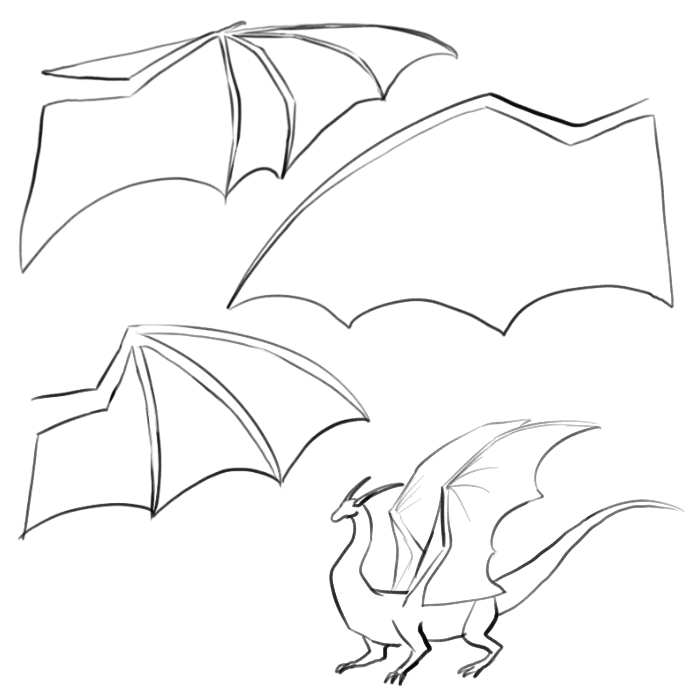
The examples below are not accepted as leather wings without the corresponding traits. The first and second are missing supports, which can only be done with the boneless trait. The third has long extensions rather than a bat-like or pterodactyl-like structure. The last example shows a ‘tail’ of leather not attached to the body. Any leather on the bottom edge must attach to the body.
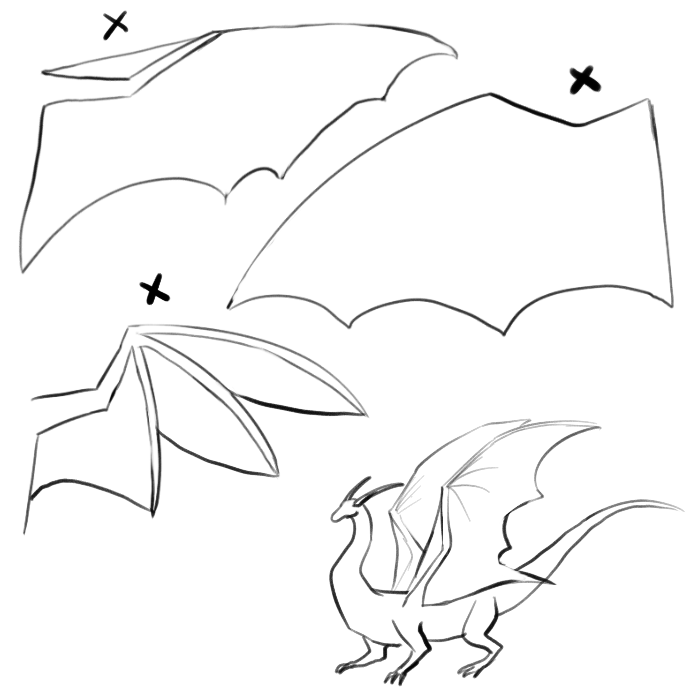
Interactions
- Scalestain - You may use Scalestain to add extensions or unnatural shape to the wings, as long as it's within the item's usual range.
- Skittertint - You may add an extra color to the gradient of the wings. You may use multiple Skittertints for multiple extra colors.
- Loremark - You may use Loremark as usual on the wings.
- Tattered - You may use Tattered to create random holes and chips in the wings. Most of the damage will be on the edge of the wing.
- Surgical Kit - You may use Surgical Kit to hide the trait. You may also remove all or significant parts of the leather.
- Transparent Skin - Transparent Skin may affect the finger and arm part of the wing, but not the leather.
- Pollen - Pollen affects wings normally, hiding any marking that would be in the area.
Unless the dragon has Mythic Wings, Mythic Body, or the Multi-winged mutation, wings will always attach on the back of the dragon, somewhere between the neck and tail and above the legs.
F.A.Q.
How do I make this type of wing?
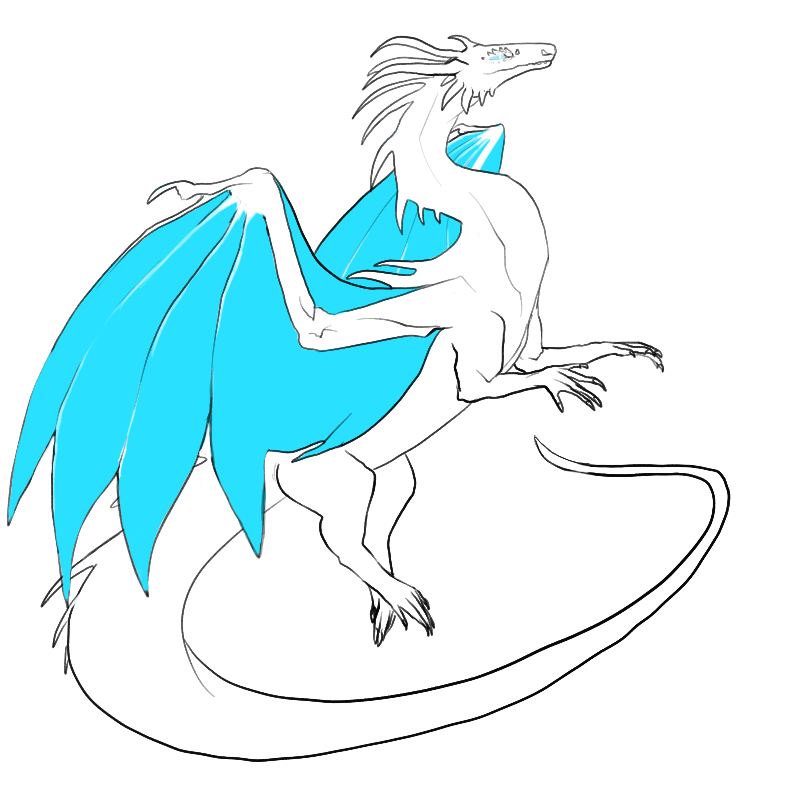
You would use Extensions or Surgical Kit. A random/rough looking version may be achieved with Tattered. Please note that dragons should not imitate Closed or Copyrighted species. If the rest of the dragon looks too much like a Leonopteryx or similar species, it will be denied.
Feathered Wings
Default to: Wind
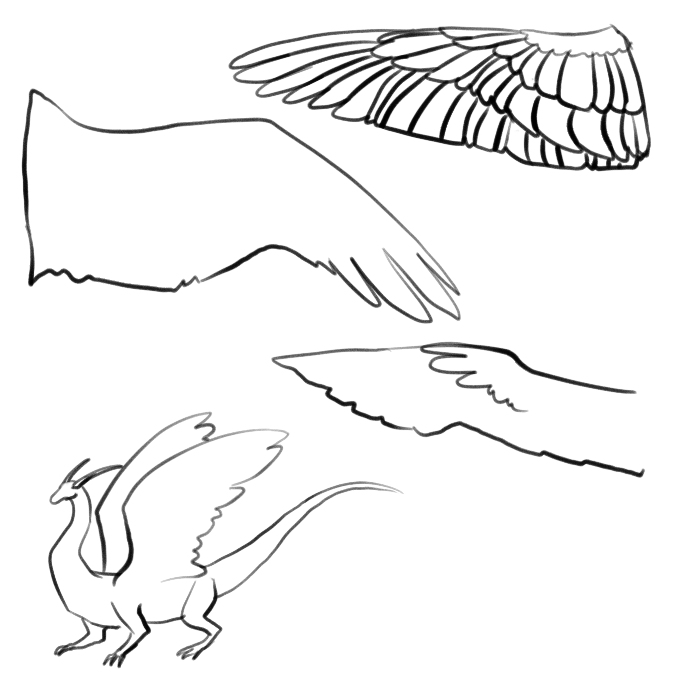
Wings that resemble that of a bird or bird-like theropod. The feathers will usually be long and capable of flight. You may choose to replace the feathers with proto-feathers or shorten them if desired, but this will make the dragon flightless. Feathered wings may either use the normal gradient across the whole wing or use different solid colors for each layer of feathers (black flight feathers, white coverts, etc. within color rules) for up to three different-colored layers. You do not need to draw each individual feather.
Interactions
- Scalestain - You may use Scalestain to add extensions or unnatural shape to the wings, as long as it's within the item's usual range.
- Skittertint - You may add an extra color to the gradient of the wings. You may use multiple Skittertints for multiple extra colors.
- Loremark - You may use Loremark as usual on the wings. Removing a feather only counts for the area of the feather's base, no matter how long the removed feather might be.
- Tattered - You may use Tattered to create random holes and chips in the wings. Most of the damage will be on the edge of the wing.
- Surgical Kit - You may use Surgical Kit to hide the trait. You may also remove large amounts of feathers or even all of them.
- Transparent Skin - Transparent Skin may affect the finger and arm part of the wing, but not the leather.
- Pollen - Pollen affects wings normally, hiding any marking that would be in the area.
Unless the dragon has Mythic Wings, Mythic Body, or the Multi-winged mutation, wings will always attach on the back of the dragon, somewhere between the neck and tail and above the legs.
Insect Wings
Default to: Jungle
Wings heavily inspired by insects! You may have one or two pairs of wings. The ‘cover’ typical of beetles counts as a set of wings. You may imitate the shape of any living insect wings (such as Luna Moths or beetles). They must have at least 90% opacity, even if their inspiration is transparent. They will not show iridescence without the proper trait. Insect Wings will be in their own segment. The wing section will not be directly attached to the body.
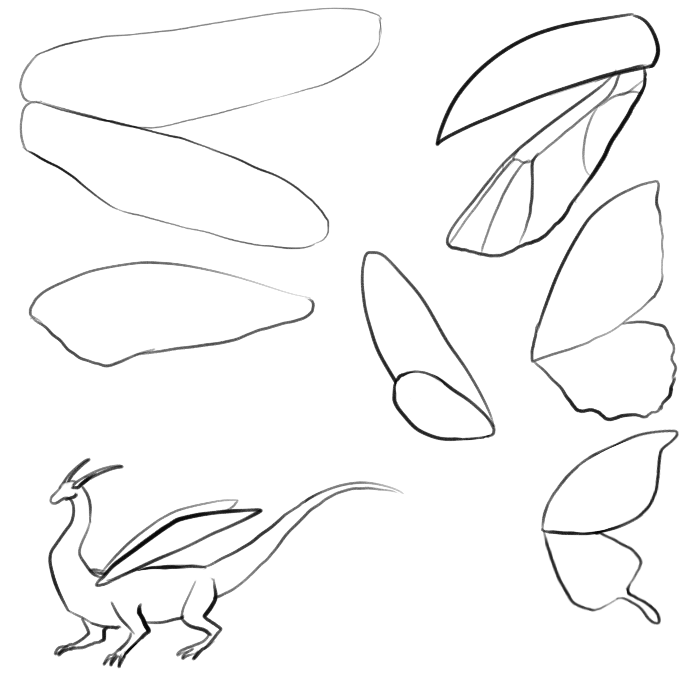
Interactions
- Scalestain - You may use Scalestain to add extensions or unnatural shape to the wings, as long as it's within the item's usual range.
- Skittertint - You may add an extra color to the gradient of the wings. You may use multiple Skittertints for multiple extra colors.
- Loremark - You may use Loremark as usual on the wings.
- Tattered - You may use Tattered to create random holes and chips in the wings. Most of the damage will be on the edge of the wing.
- Surgical Kit - You may use Surgical Kit to hide the trait. You may also use it to create unnatural shapes. When using Surgical Kit to shape the wing, it only affects two wings symmetrically at a time.
- Transparent Skin - Transparent Skin will not affect the wings.
- Pollen - If Pollen affects Insect Wings, you may make it a normal skin tone or you may make the area transparent. These two effects don't mix. The transparency may be sharp or gradual from the regular colors.
Unless the dragon has Mythic Wings, Mythic Body, or the Multi-winged mutation, wings will always attach on the back of the dragon, somewhere between the neck and tail and above the legs.
Artificial Wings
Default to: Thunder
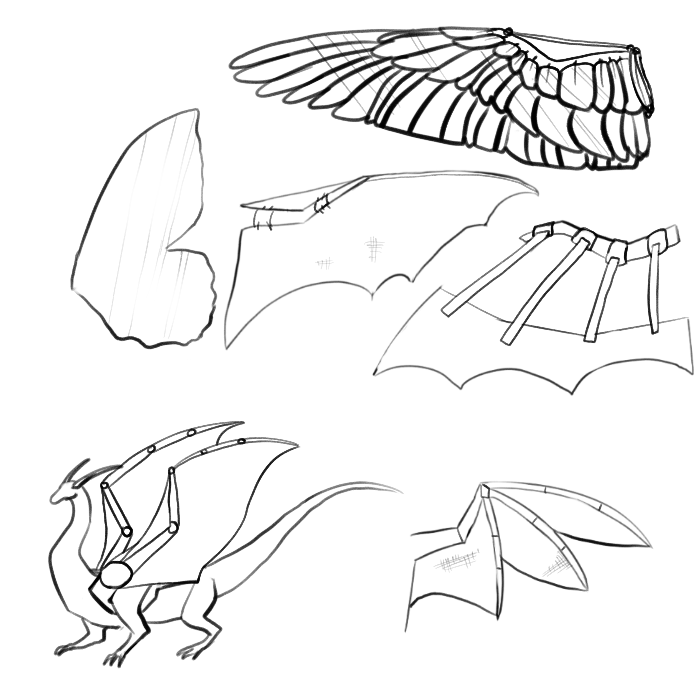
These may resemble any sort of wings, as long as it is clear that they are constructed out of metal, clay, or another artificial material (see below for options). Materials (including glass and plastic) must have at least 90% opacity. You may choose to draw the dragon without artificial wings. In that situation, the dragon would be either wingless or show some sort of condition that would keep it from flying normally.
The shape may be close to natural wings or a little abstract, but it should be very obvious that the wings are artificial in some way. Artificial wings will not float off the body. You may put jetpacks on dragons with Artificial Wings, as long as they are simple in design/materials and have no stamps/labels/etc. without the proper trait or item.
The following list has a few acceptable materials for artificial traits. Their colors must be at 90% opacity or more (see colors for more info on transparency and color). If you do not see something on this list, feel free to ask if it is available!
- Plastic
- Clay
- Metal
- Glass
- Cloth
- Wood
- Bone (note–must be carved/shaped rather than a skeleton on top of the dragon)
All traits must be visibly artificial in order to pass. In example, clay would have a few cracks or flakes, cloth would have something tying it to the rest of the dragon, and metal would have screws on the edges holding them together. You may use up to two materials. Each material must be the same color as all matching materials. In example, if you want to use brown clay as a material, then all other clay must match. Wires, screws, and simple fasteners do not count towards the material limit and may have their own color that matches something else on the dragon. The colors of these extras must still match each other.
Colors
Artificial traits will only have colors natural to their material or colors in the elemental spectrum. For example, a fire dragon cannot be covered in lime green metal. The natural colors of plastics are white and tan. The natural colors of cloth depend on the material used to make them; For that, stick to plant materials in our known universe. Cloth traits cannot be dyed without the Scalestain item. Glass will always be tinted white or an elemental color. Clay will take on white, gray, light steel blue, red, orange, brown, or tan colors, similar to the ones seen in the Earth palette.
As elemental creatures, the magic of your dragon may also color its features their corresponding elemental color, even if it is outside of that material’s natural range. In this situation, it will only be one or the other (a red clay + blue ocean element color can’t equal purple). The reason that glass will never be fully transparent is because of this ‘leaking’ magic effect.
Artificial traits may have a sheen/shine if it’s a material that naturally does that.
Display Traits
Similarly to color, a dragon’s display traits will always show, even if they need to leak through the artificial materials. While you can have artificial materials cover traits, they must still be apparent somewhere on the dragon. In example, if your dragon has Zebra, you may limit its stripes to the face and legs if your dragon’s body is covered in artificial scales. When the artificial parts are removed, you may have markings appear underneath, or simply leave that area blank.
What’s Underneath
The purpose of artificial traits is typically to aid in the health of the dragon. No dragon is born with their artificial traits included–their Rider, a passerby, or they themselves will construct something for them. Here are some reasons that a dragon may need an artificial wings: missing wings, malformed wings, can't fly, or simply wants wings.
With that in mind, the traits underneath resemble traits you can see in other dragons. When your dragon has their artificial parts off, they will resemble a malformed version of a parent’s trait (with the exception of mythical traits, which will only produce a default option) or malformed/missing leather wings.
A Matter of Pride
Of course, there are many reasons that a dragon may not need artificial traits at all. There are crestless dragons that live their life just fine, wyrms that have no need of legs, and wingless critters that are content with their position on the ground. For dragons on the healthier scale of things--especially those of the Thunder element--artificial traits are a way to boost their confidence and have traits they believe is required for them, regardless of whether or not they really need that giant crown-shaped crest.
Going Without
Similar to healthy dragons which insist on their custom artificial traits, there may be some dragons with health issues that choose to go without. These dragons may choose to only partially cover their scales, replace only a single limb and leave the others mismatched, or even go without an aid entirely. If your dragon goes without, its design must follow the ‘What’s Underneath’ section above.
Interactions
- Scalestain - You may use Scalestain to add extensions or unnatural shape to the wings, as long as it's within the item's usual range.
- Skittertint - You may add an extra color to the gradient of the wings. You may use multiple Skittertints for multiple extra colors.
- Loremark - You may use Loremark as usual on the wings.
- Tattered - You may use Tattered to create random holes and chips in the wings. Most of the damage will be on the edge of the wing.
- Surgical Kit - Surgical Kit has no effect on Artificial Wings.
- Transparent Skin - Transparent Skin may affect the finger and arm part of the wing if present. It will not affect artificial materials, leather, feathers, or other natural wing parts that might be present.
- Pollen - Pollen affects wings normally, hiding any marking that would be in the area.
Unless the dragon has Mythic Wings, Mythic Body, or the Multi-winged mutation, wings will always attach on the back of the dragon, somewhere between the neck and tail and above the legs.
Scythe Wings
Default to: Metal
Large, curved, movable scales that project from the same area and loosely resemble wings.
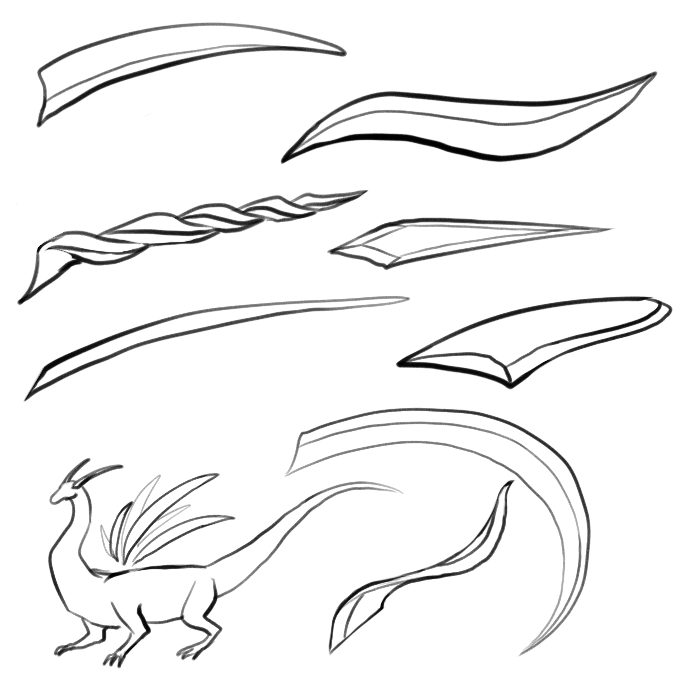
They are created by a unique magnetic field around the dragon. This same magnetic field will allow some wings to float off of the body. Scythe Wings will start at the shoulders and the blades may float down to above the hip bones. No matter where they are, they will angle towards the shoulders, even if very slightly. The entire scale may also be spiraled. They are a solid material and are sharp enough to be used as their namesake; they usually appear bright and reflective, but some dragons may keep their blades dull. You may depict them with metal-like shading even without the Sheen trait. Scythe “wings” do not aid in flight, rendering dragons with scythe wings flightless. They will angle towards the shoulders, rather than down the back as spines.
Interactions
- Scalestain - You may use Scalestain to add extensions or unnatural shape to the wings, as well as additional points, as long as it's within the item's usual range.
- Skittertint - You may add an extra color to the gradient of the wings. You may use multiple Skittertints for multiple extra colors. You may alternatively use Skittertint to make mis-matched wings, where one wing is pink and the other silver, for example. Mis-matched wings do not need to be symmetrical. Any number of blades may be affected by one Skittertint, as long as they are the same color.
- Loremark - You may use Loremark as usual on the wings.
- Tattered - You may use Tattered to create random holes and chips in the wings. Most of the damage will be on the edge of the wing.
- Surgical Kit - Surgical Kit has no effect on Artificial Wings.
- Transparent Skin - Transparent Skin will not affect Scythe Wings.
- Pollen - Pollen affects wings normally, hiding any marking that would be in the area. Optionally, you may make shiny wings dull in areas that Pollen touches.
Unless the dragon has Mythic Wings, Mythic Body, or the Multi-winged mutation, wings will always attach on the back of the dragon, somewhere between the neck and tail and above the legs.
Mythic Wings
This allows you to have a free-for-all in how you design your dragon’s wings! Your wings may also attach in any location and appear in any number. It is an incredibly rare trait, with a very low chance of passing down. It may have any of these modifiers for free, as long as they resemble wings/affect wings: Iridescence, Bioluminescence, Heraldry, Plating, Spines, Horns, Translucence, Transparency, Different Wing Types, Miniature, Disassembly, Glitch, Coils, Halo, Display, Protofeathers, Velvet Scales, Bumble, Curled, Smooth Scales, Tentacles, Many-finned, Gilled, Curled, Seraph, Filled, Plumes, Extensions, Companion, True Sight, Boneless, Tattered, Engraved, Shimmer, Gilded, Sheen, Armored.
In addition to any of those modifiers, you can get creative. Want to reference extinct species? Go for it! Want to make up your own anatomy? That's an option, too! Want to keep things simple and just give them a bunch of regular wings? Honestly, the options are limitless. Have fun!
Amphibious Limbs
Legs should follow the body shape rules–the center of mass should be further forward for quadrupedal dragons and further back for bipedal dragons. The scales of all dragons may switch to smooth scales at some point between the shoulder and claws; if they do, it will match the color of anywhere else on the dragon with smooth scales. This smooth-scaled area may have a different color than the normal base, as long as it’s within elemental rules. If a dragon is already smooth-scaled, then it will all be one solid color.
Amphibious limbs are smooth limbs with nubs for fingers. The legs are quite flexible and can end up in strange positions. They don’t have claws. They can have webbing between their toes. When drawing amphibious limbs, you can reference any living amphibian for your design.
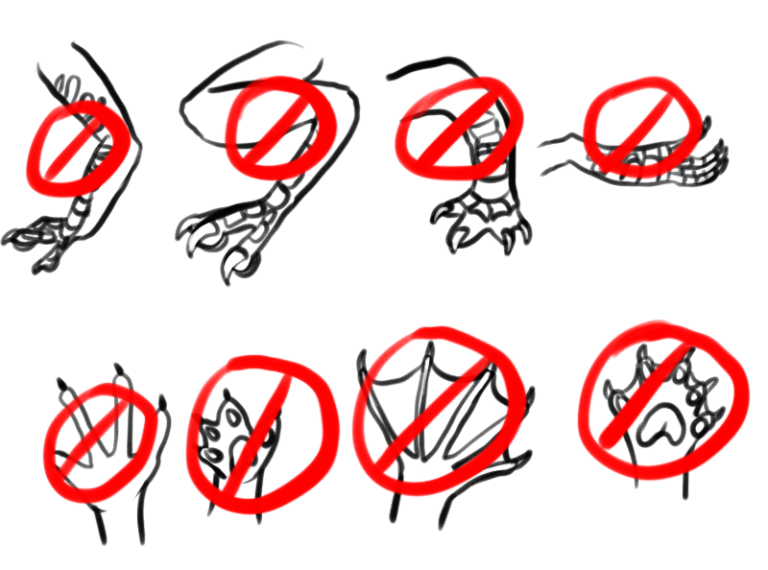
Unlike other dragons with smooth scales, amphibious limbs will not have scutes or plating on the feet. They will never have paw pads or claws without the corresponding modifier.
How do I make wolf feet/cat feet/[insert animal here]?
There are three ways to give your dragon paws. The first is to have mythic limbs, which allows lots of legs, different legs, and almost limitless possibilities for your limbs. The second method, and by far the easiest, is to have a dragon with fingered limbs. Lastly, there is the brawn trait. This rare Earth trait can give your dragon the feet of any land-based animal you can think of.
Can I make mis-matched legs?
If your feet are within the same type of leg (such as a sea turtle and a bird both being reptilian), then you may mix them without any extra stuff. Mythic limbs allow mis-matched legs. Brawn allows you to mix in pairs–which means the front can be bird-like, and the back can be paws–similar to a gryphon!
Artificial Scales
Scales may be made of metal, clay, bone, or some other artificial or sculpted substance. They can take any shape, but always serve as a functional covering rather than a decoration. If their natural scales are visible, then there should be an attachment where the artificial scales begin (screws, string, stitching, etc.). If depicted, artificial pieces must cover at least 1/6th of the body. It may blend and connect with other artificial traits, so long as it follows the other rules.
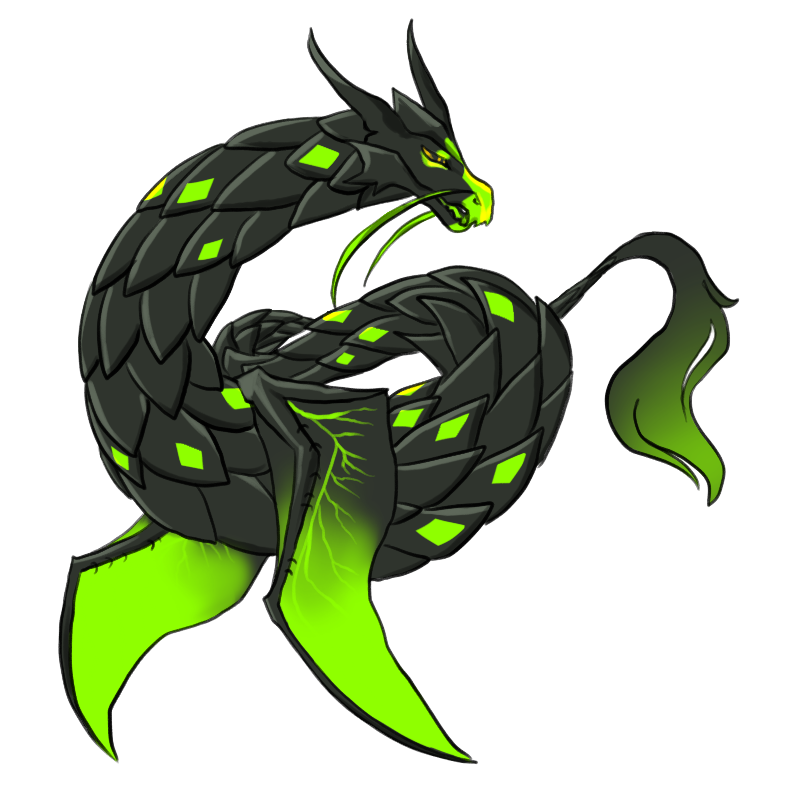
The following list has a few acceptable materials for artificial traits. Their colors must be at 90% opacity or more (see colors for more info on transparency and color). If you do not see something on this list, feel free to ask if it is available!
- Plastic
- Clay
- Metal
- Glass
- Cloth
- Wood
- Bone (note–must be carved/shaped rather than a skeleton on top of the dragon)
All traits must be visibly artificial in order to pass. In example, clay would have a few cracks or flakes, cloth would have something tying it to the rest of the dragon, and metal would have screws on the edges holding them together. You may use up to two materials. Each material must be the same color as all matching materials. In example, if you want to use brown clay as a material, then all other clay must match. Wires, screws, and simple fasteners do not count towards the material limit and may have their own color that matches something else on the dragon. The colors of these extras must still match each other. Fur, feathers, and anything that resembles natural scales will not be accepted even if they are attached with strings, nails, plates, or other artificial things.
Colors
Artificial traits will only have colors natural to their material or colors in the elemental spectrum. For example, a fire dragon cannot be covered in lime green metal. The natural colors of plastics are white and tan. The natural colors of cloth depend on the material used to make them; For that, stick to plant materials in our known universe. Cloth traits cannot be dyed without the Scalestain item. Glass will always be tinted white or an elemental color. Clay will take on white, gray, light steel blue, red, orange, brown, or tan colors, similar to the ones seen in the Earth palette.
As elemental creatures, the magic of your dragon may also color its features their corresponding elemental color, even if it is outside of that material’s natural range. In this situation, it will only be one or the other (a red clay + blue ocean element color can’t equal purple). The reason that glass will never be fully transparent is because of this ‘leaking’ magic effect.
Artificial traits may have a sheen/shine if it’s a material that naturally does that.
Display Traits
Similarly to color, a dragon’s display traits will always show, even if they need to leak through the artificial materials. While you can have artificial materials cover traits, they must still be apparent somewhere on the dragon. In example, if your dragon has Zebra, you may limit its stripes to the face and legs if your dragon’s body is covered in artificial scales. When the artificial parts are removed, you may have markings appear underneath, or simply leave that area blank.
What’s Underneath
The purpose of artificial traits is typically to aid in the health of the dragon. No dragon is born with their artificial traits included–their Rider, a passerby, or they themselves will construct something for them. Here are some reasons that a dragon may need artificial scales: Scales prone to scratches, sunburns, and bruising; scales completely missing from areas.
With that in mind, the traits underneath resemble traits you can see in other dragons. When your dragon has their artificial parts off, they will resemble a malformed version of a parent’s trait (with the exception of mythical traits, which will only produce a default option) or smooth scales with some kind of visible issue.
A Matter of Pride
Of course, there are many reasons that a dragon may not need artificial traits at all. There are crestless dragons that live their life just fine, wyrms that have no need of legs, and wingless critters that are content with their position on the ground. For dragons on the healthier scale of things--especially those of the Thunder element--artificial traits are a way to boost their confidence and have traits they believe is required for them, regardless of whether or not they really need that giant crown-shaped crest.
Going Without
Similar to healthy dragons which insist on their custom artificial traits, there may be some dragons with health issues that choose to go without. These dragons may choose to only partially cover their scales, replace only a single limb and leave the others mismatched, or even go without an aid entirely. If your dragon goes without, its design must follow the ‘What’s Underneath’ section above.
Common Interactions
- Accents - These affect the scales within the normal range. The edges of artificial scales do not add extra accents.
- Skittertint - Skittertint does not affect base scales.
- Scalestain - Scalestain does not affect Artificial Scales.
- Loremark - Loremark can create etchings within its usual range. In places where Artificial Scales do not cover, Loremarks has a regular effect.
- Tattered - Tattered may cause scales to have large breaks or hang off the body. It can affect up to 1/3rd of the artificial scales. Charged Tattered can affect 3/4ths of the artificial scales. These scales will never float.
- Surgical Kit - Surgical Kit has no effect on Artificial Scales.
- Transparent Skin - Artificial Scales will always be on top of Transparent Skin.
- Pollen - If pollen appears elsewhere on the body and touches artificial scales, the artificial scales may optionally become discolored to match the body's Pollen. If there is no area where natural Pollen shows, then they have to show somewhere on the scales.
- Display - Display will not affect the base scales.
- Extensions - Extensions does not affect Artificial Scales. To create large artificial structures, you will need the Large Adornments item.
- Coils - When Coils is present, it may be intertwined with the Artificial Scales without counting as part of the materials.
- Companion - Mini-me type companions do not need to have Artificial Scales, even if the main dragon has them showing. The reverse is true--the Mini-me can show Artificial Scales while the main dragon goes without. Mini-mes do not need Monstrous effects when going without, but the main dragon will.
F.A.Q.
How do Artificial Scales react to Monstrous Body?
It's possible for the mist or goop from monstrous body to seep out around the edges of artificial scales. Artificial Scales will never go underneath bony structures created by monstrous body.
How do Bumble, Protofeathers, and other fuzzy traits affect Artificial Scales?
It's possible to have fur/feathers/hair come out from underneath the scales. As long as both traits are visible, you can layer them however you like.
Can Artificial traits discolor scales?
Yes, they can discolor scales! If your dragon wears their constructs frequently (it is depicted on their import sheet), you may choose to have the scales directly underneath be lighter or darker. The markings underneath will remain the same color.
Aquatic Limbs
Legs should follow the body shape rules–the center of mass should be further forward for quadrupedal dragons and further back for bipedal dragons. The scales of all dragons may switch to smooth scales at some point between the shoulder and claws; if they do, it will match the color of anywhere else on the dragon with smooth scales. This smooth-scaled area may have a different color than the normal base, as long as it’s within elemental rules. If a dragon is already smooth-scaled, then it will all be one solid color.
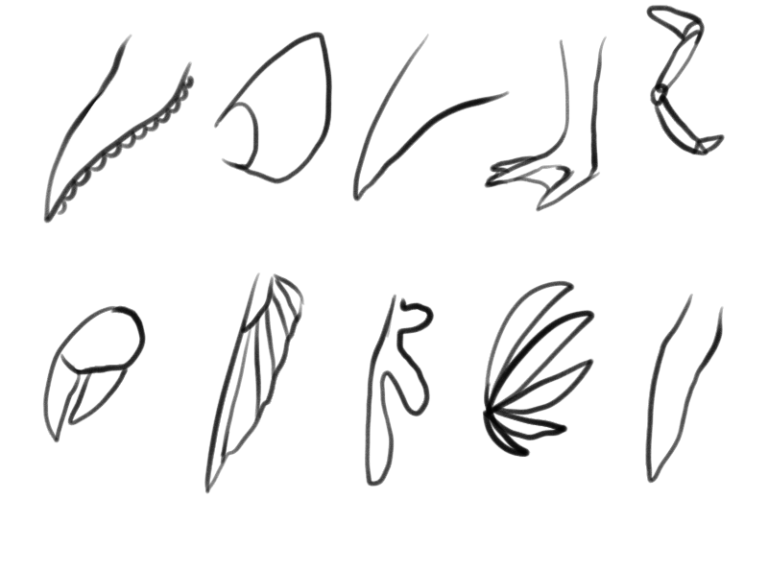
Fins, flippers, or limbs adapted to aquatic life! Animals that simply hunt in the water do not count for aquatic limbs if their feet are not adapted to water. You are still limited to the amount of limbs determined by the dragon’s body type, and the limbs must be in the appropriate parts of your dragon’s body type.
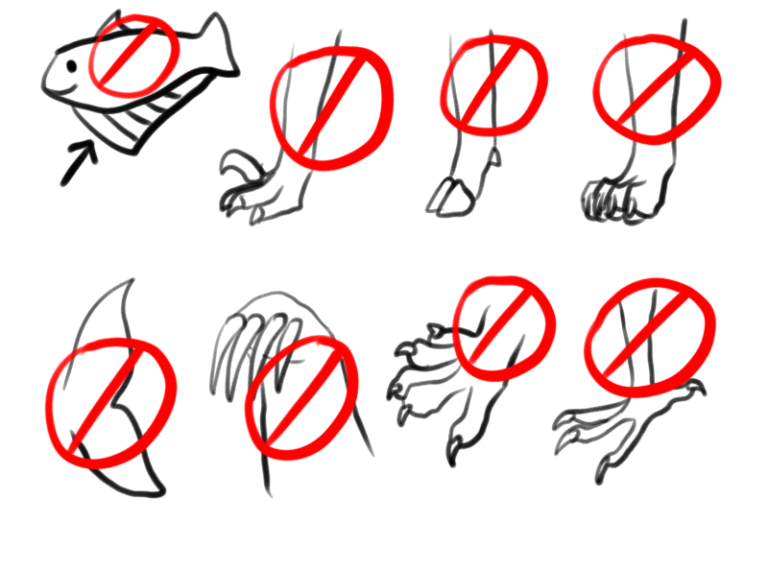
How do I make wolf feet/cat feet/[insert animal here]?
There are three ways to give your dragon paws. The first is to have mythic limbs, which allows lots of legs, different legs, and almost limitless possibilities for your limbs. The second method, and by far the easiest, is to have a dragon with fingered limbs. Lastly, there is the brawn trait. This rare Earth trait can give your dragon the feet of any land-based animal you can think of.
Can I make mis-matched legs?
If your feet are within the same type of leg (such as a sea turtle and a bird both being reptilian), then you may mix them without any extra stuff. Mythic limbs allow mis-matched legs. Brawn allows you to mix in pairs–which means the front can be bird-like, and the back can be paws–similar to a gryphon!
Fingered Limbs
Legs should follow the body shape rules–the center of mass should be further forward for quadrupedal dragons and further back for bipedal dragons. The scales of all dragons may switch to smooth scales at some point between the shoulder and claws; if they do, it will match the color of anywhere else on the dragon with smooth scales. This smooth-scaled area may have a different color than the normal base, as long as it’s within elemental rules. If a dragon is already smooth-scaled, then it will all be one solid color.
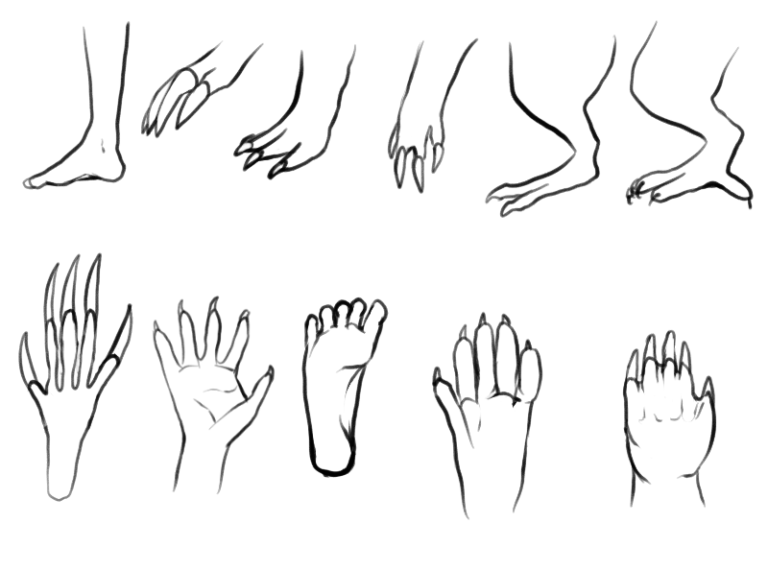
Legs with fingered feet that resemble that of lemurs, monkeys, shrews, rabbits, bats, rodents, canines, or any members of Euarchontoglires. You may include digging claws and paw pads. They must always have some sort of opposing thumb on the front limbs–this can appear in the shape of a dewclaw if needed. They will have four or five toes per foot. The front limbs should be able to grasp.
How do I make wolf feet/cat feet/[insert animal here]?
There are three ways to give your dragon paws. The first is to have mythic limbs, which allows lots of legs, different legs, and almost limitless possibilities for your limbs. The second method, and by far the easiest, is to have a dragon with fingered limbs. Lastly, there is the brawn trait. This rare Earth trait can give your dragon the feet of any land-based animal you can think of.
Can I make mis-matched legs?
If your feet are within the same type of leg (such as a sea turtle and a bird both being reptilian), then you may mix them without any extra stuff. Mythic limbs allow mis-matched legs. Brawn allows you to mix in pairs–which means the front can be bird-like, and the back can be paws–similar to a gryphon!
Reptilian Limbs
Legs should follow the body shape rules–the center of mass should be further forward for quadrupedal dragons and further back for bipedal dragons. The scales of all dragons may switch to smooth scales at some point between the shoulder and claws; if they do, it will match the color of anywhere else on the dragon with smooth scales. This smooth-scaled area may have a different color than the normal base, as long as it’s within elemental rules. If a dragon is already smooth-scaled, then it will all be one solid color.
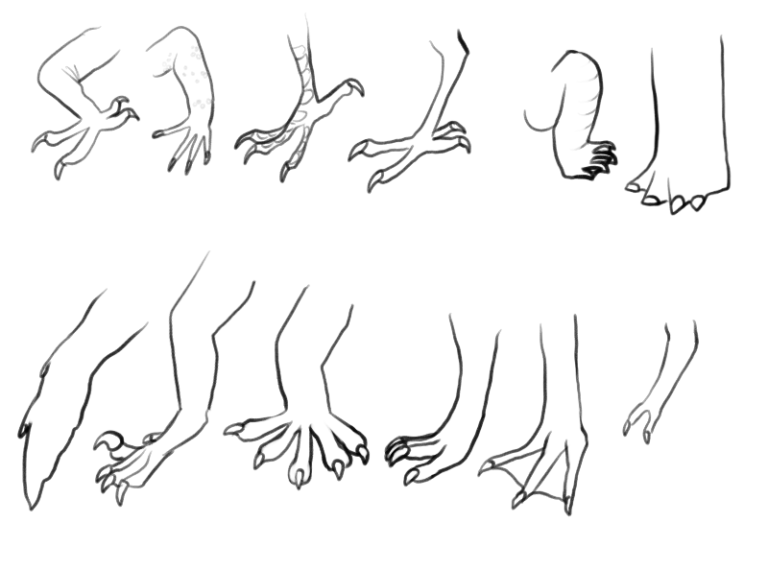
Inspirations: Chameleons, Parrots, Hawks, Tortoises, Brachiosaurus, Sea Turtles, Velociraptors, Geckos, Lizards, Ducks, T-Rex
Reptilian legs ending in smooth, clawed, elongated toes. These toes usually have spaces in between them and will never look like paws. Lizards, birds, and dinosaurs are just a few examples you can pull from. They will always have claws. You may give them larger scales or scutes leading up to their toes. They typically point in different directions, rather than having the toes point towards a ‘center.’ You may use any reptile or bird as an example.
Here are some examples of Reptilian Limbs that don’t work:
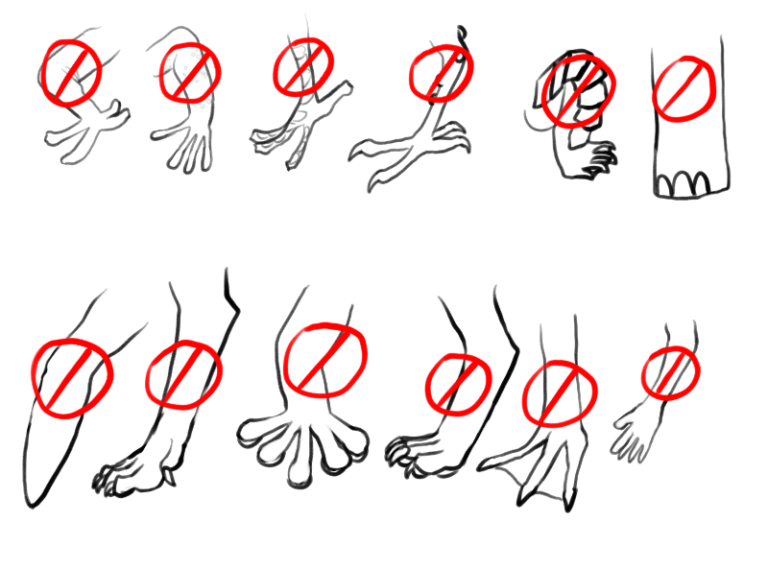
Issues for each limb:
Row One: 1, there are no claws ; 2, there are no claws; 3, there are no claws ; 4, there are odd bumps. although the toes are pointy, that does not mean 100% they have claws, so they won’t count; 5: the scutes look more like armor and will need to be toned down; 6: the toes are too concentrated in one spot | Row Two: 1, This sea turtle fin does not show claws ; 2, While the feet are clawed and the toes are similar to alligators, there are no spaces between them and the four bottom toes point towards the center. Even though there are no paw pads, they resemble paws; 3, there are paw pads and no claws; 4, there are paw pads, no space between the toes, and the toes point inwards. they look too much like paws; 5, there are no claws. Points are not accepted as claws. ; 6, how did this even happen, it is a human hand and definitely not reptilian
How do I make wolf feet/cat feet/[insert animal here]?
There are three ways to give your dragon paws. The first is to have mythic limbs, which allows lots of legs, different legs, and almost limitless possibilities for your limbs. The second method, and by far the easiest, is to have a dragon with fingered limbs. Lastly, there is the brawn trait. This rare Earth trait can give your dragon the feet of any land-based animal you can think of.
Can I make mis-matched legs?
If your feet are within the same type of leg (such as a sea turtle and a bird both being reptilian), then you may mix them without any extra stuff. Mythic limbs allow mis-matched legs. Brawn allows you to mix in pairs–which means the front can be bird-like, and the back can be paws–similar to a gryphon!
Ungulate Limbs
Legs should follow the body shape rules–the center of mass should be further forward for quadrupedal dragons and further back for bipedal dragons. The scales of all dragons may switch to smooth scales at some point between the shoulder and claws; if they do, it will match the color of anywhere else on the dragon with smooth scales. This smooth-scaled area may have a different color than the normal base, as long as it’s within elemental rules. If a dragon is already smooth-scaled, then it will all be one solid color.
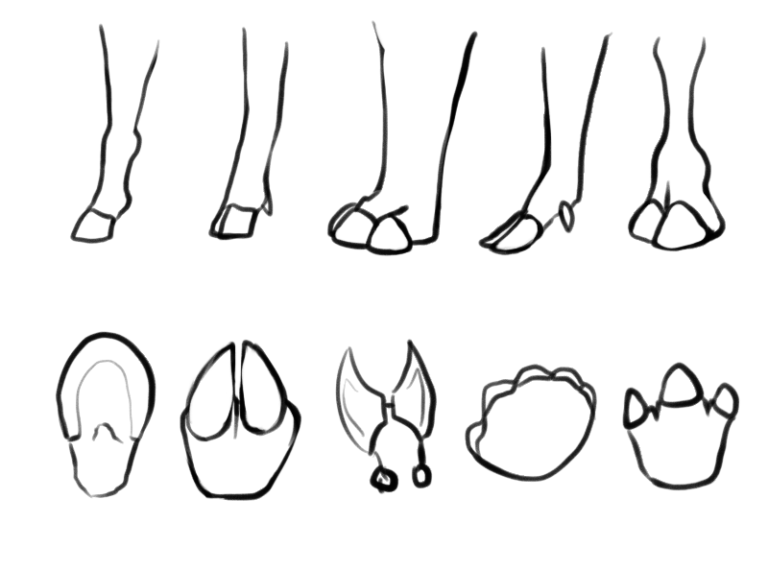
Any sort of hooved legs from the ungulate family that are not extinct. This includes zebra, camels, rhinoceros, bison, hippopotami, horses, elephants, and pigs. This does not include whales or extinct ungulates. Below are examples of what not to do!
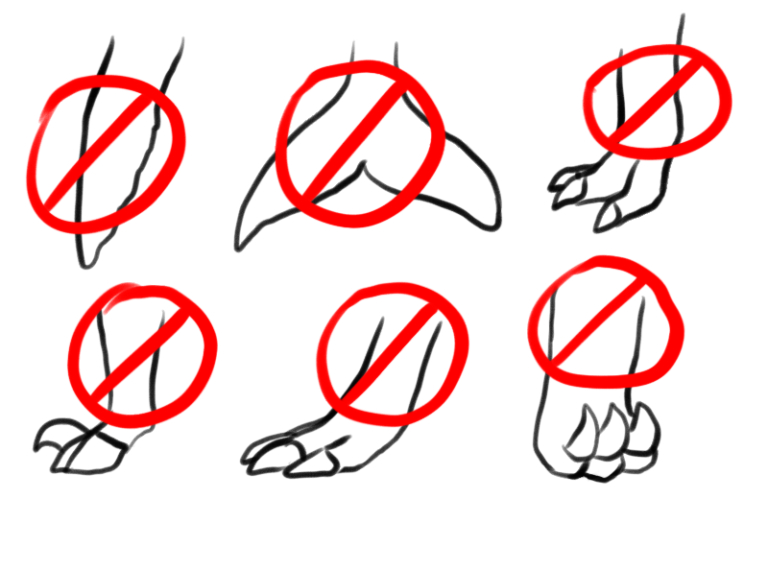
How do I make wolf feet/cat feet/[insert animal here]?
There are three ways to give your dragon paws. The first is to have mythic limbs, which allows lots of legs, different legs, and almost limitless possibilities for your limbs. The second method, and by far the easiest, is to have a dragon with fingered limbs. Lastly, there is the brawn trait. This rare Earth trait can give your dragon the feet of any land-based animal you can think of.
Can I make mis-matched legs?
If your feet are within the same type of leg (such as a sea turtle and a bird both being reptilian), then you may mix them without any extra stuff. Mythic limbs allow mis-matched legs. Brawn allows you to mix in pairs–which means the front can be bird-like, and the back can be paws–similar to a gryphon!
Mythic Limbs
This allows you to have a free-for-all in how you design your dragon’s limbs! You may have any number and they may attach or float anywhere. It is an incredibly rare trait, with a very low chance of passing down. It may have any of these modifiers for free, as long as they are affecting the limbs: Iridescence, Bioluminescence, Heraldry, Plating, Spines, Translucence, Spines, Transparency, Insectified, Miniature, Disassembly, Glitch, Coils, Halo, Display, Brawn, Protofeathers, Capricorn, Tentacles, Fins, Debris, Bumble, Odd Ears, Curled, Seraph, Frilled, Plumes, Extensions, Companion, Multi-limbed, True Sight, Boneless, Tattered, Engraved, Shimmer, Gilded, Sheen, Armored.
In addition to any of those modifiers, you can get creative. Want to reference extinct species? Go for it! Want to make up your own anatomy? That's an option, too! Want to keep things simple and just give them some paws? Honestly, the options are limitless. Have fun!
Whip Tail
There is no maximum limit on tail length. However, your dragon’s tail must be long enough to be able to touch the ground. Legs will not attach to the tail.
Whip tail is a long, serpentine tail that ends in a taper. Simple in shape. It has strong musculature and decent weight to help with stabilization. Some dragons may even use them as a weapon (thus, their name).
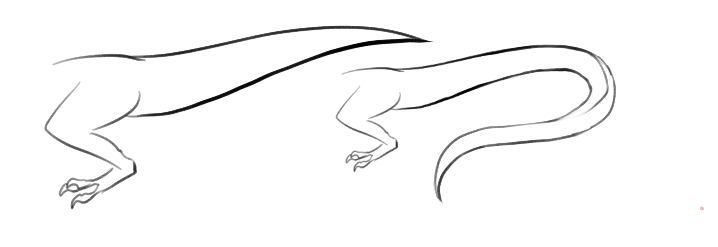
Color Rules
Whip Tail will always be the same color as the rest of the body. Traits may extend to it.
Size & Range
There is no maximum limit on tail length. However, your dragon’s tail must be long enough to be able to touch the ground. Legs will not attach to the tail. Unless a dragon has Tailless, there must be a central bony area that tapers as it reaches the end--the same as a lizard or snake.
Shape
Whip Tails start off at the same size as the body and tapers slowly to the end. It will NOT resemble a cat tail, dog tail, or rat tail--those tails start off much skinnier and only taper at the end. Iguanas are a good living example of a Whip Tail, but you can also look at Diplodocus and other dinosaurs for an idea of what to do.
What’s the difference between whip tail and rat tail?
Rat tail starts off skinny and ends up skinny, similar to rats and other mammals, with very little muscle. On the other hand, Whip tail starts the same width as the body and gradually tapers, similar to lizards and other reptiles, and it has strong musculature.
What is the maximum/minimum tail length?
There is no maximum limit on tail length. However, your dragon’s tail must be long enough to be able to touch the ground.
How can I get multiple tails?
The split tail mutation.
Tufted Tail
A serpentine or wired tail that ends in a tuft of fur. The tuft of fur at the end may be any color within elemental rules. The bony part of the tail may be thin or thick, as well as short or long. There is also no length limit to the tuft. However, the tail will need at least part of it to be bony without the tuft. The tuft area may have minimal support, similar to a horse tail.
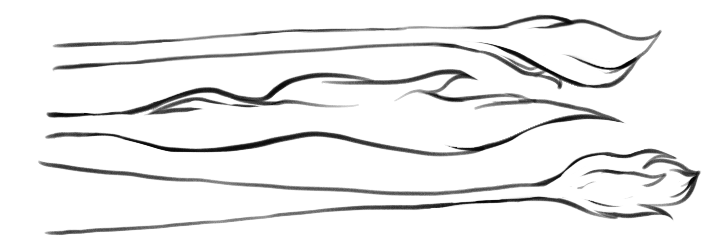
How do I make a wolf tail?
Rat tail + tailless + velvet scales or similar traits.
What is the maximum/minimum tail length?
There is no maximum limit on tail length. However, your dragon’s tail must be long enough to be able to touch the ground.
How can I get multiple tails?
The split tail mutation.
Rat Tail
A thin tail that keeps its width throughout the tail. It starts abruptly and ends abruptly. It contains bone with very little flesh or muscle. You may choose whether or not scales appear on this tail.
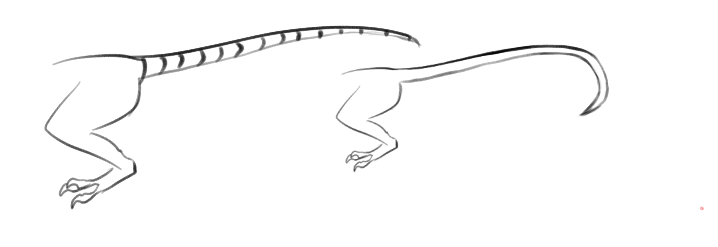
Color Rules
You may choose for Rat Tail to have no scales. If you do remove them, then the tail will follow regular flesh color rules. If flesh is showing elsewhere on the dragon, then the tail will match that color.
If you decide to keep scales on the Rat Tail, then they are treated like regular scales and will be the same color as the base.
Size & Range
There is no maximum limit on tail length. However, your dragon’s tail must be long enough to be able to touch the ground. Legs will not attach to the tail. Unless a dragon has Tailless, there must be a central bony area.
What’s the difference between whip tail and rat tail?
Rat tail starts off skinny and ends up skinny, similar to rats and other mammals, with very little muscle. On the other hand, Whip tail starts the same width as the body and gradually tapers, similar to lizards and other reptiles, and it has strong musculature.
How can I get multiple tails?
The split tail mutation.
How do I Make a Rat-tailled Wyrm?
This should give you an idea on how a rat tail attaches to a wyrm body:
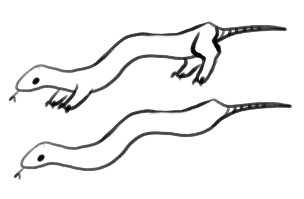
Raptor Tail
A long tail with a frill of feathers that extends from the base to the tip. The feathers will always overlap each other, like a bird’s wings or tail feathers, and never be distanced apart. Alternatively, it may be covered in short protofeathers. It should resemble the tail of Archaeopteryx, though you can also use wiry protofeathers. The feathers attach to the bone of the tail and point outwards.
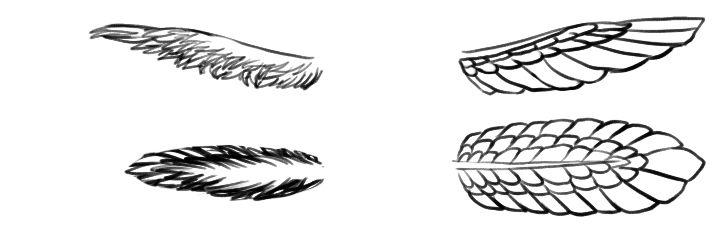
Color Rules
When presenting with full feathers, Raptor Tails may either use the normal gradient across the whole tail or use different solid colors for each layer of feathers (black primaries, white secondaries, etc. within color rules) for up to three different-colored layers. When presenting with protofeathers, it may have a gradient towards the end of the tail that lies below all other markings.
Size & Range
There is no maximum limit on tail length. However, your dragon’s tail must be long enough to be able to touch the ground. Legs will not attach to the tail. Unless a dragon has Tailless, there must be a central bony area that tapers as it reaches the end--the same as a lizard or ancient theropod.
Shape
Feathers and fur must both point towards the center area of the tail. For tails that present with full feathers, the end may have a spaded or frilled appearance that sticks out from the rest of the feathers.
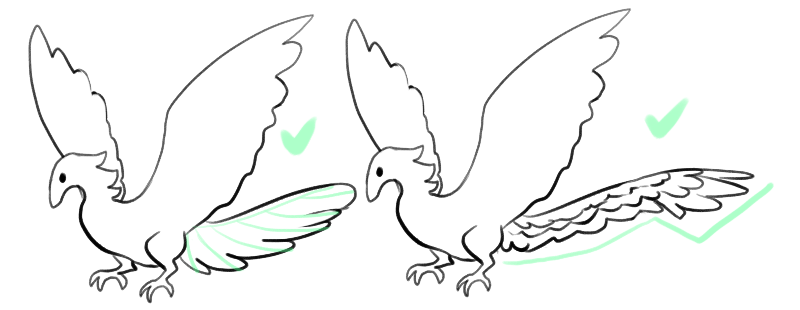
Special Interactions
- Accents (Feathered) -The end of the outer tail tips may be affected by accents. In addition, the end of the tail tip and feathers attached to it and up to three feathers attached to it may be affected by accents.
- Accents (Protofeathers) - The very end of the tail may be affected by accents.
- Transparent Skin - When presenting with full feathers, the feathers cannot be affected by Transparent Skin, but the central tail may be. When presenting as protofeathers, the fur will also be affected.
- Pollen - Pollen may appear as a gradient mark. It may optionally remove plumes and protofeathers where it touches.
- Tailless (Feathered) - In addition to completely removing the tail, you may also have plumes that attach to the base of a tail. These plumes may be tiny or long enough to touch the floor, but no longer.
- Tailless (Protofeathers) - In addition to completely removing the tail, you may give it a small, dog-like tail. The tail will still have no tufts. The protofeathers will still be short.
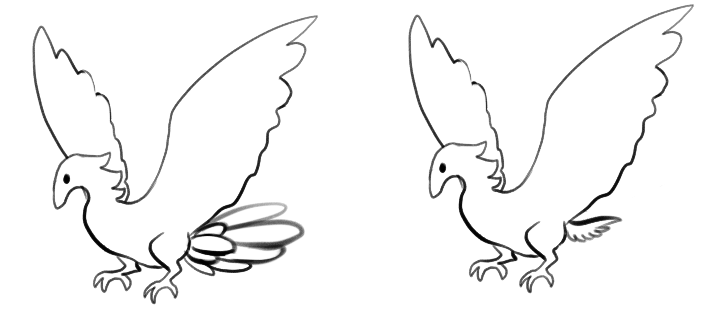
Items
- Skittertint - This allows an additional color to be used when the tail presents with a gradient.
- Scalestain - This allows stylizing of the feathers. You may have them curl or extend.
- Loremark/Tattered - This may remove up to half of the feathers. Tattered must be random, but it may damage part of the feathers rather than remove the whole feather. Loremark may trim the feathers into a shape or leave just enough feathers for a plume on the end.
- Surgical Kit - This trait may be removed with a single Surgical Kit, along with any modifiers that are exclusive to the tail.
Common Issues
Below, left: This dragon has feathers that point towards the base of the tail, rather than a central bony area. Shapes like these need at least a few lines to indicate that the tail feathers point to a central area.
Below, right: This tail presents with both protofeathers and full feathers. You can only pick one!
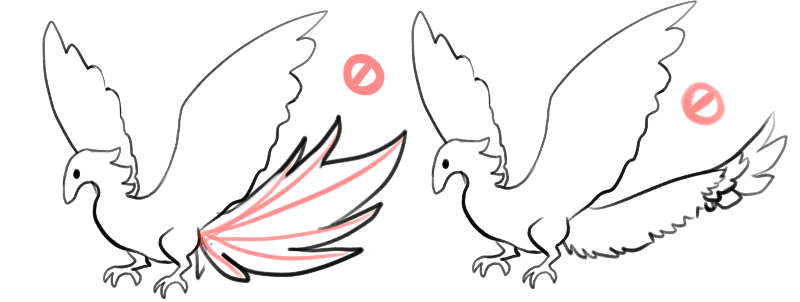
Below, left: This has a frill of feathers on the end, but not the reast of the tail. Feathers will always cover the entirety of the tail. You would need whip tail and Plumes--or similar traits--for this.
Below, right: The same applies when using protofeathers--feathers will noticeably cover the entire tail. Additionally, tails that present with protofeathers do not have a frill option for the end. You would need Heraldry or Tufted Tail for this.
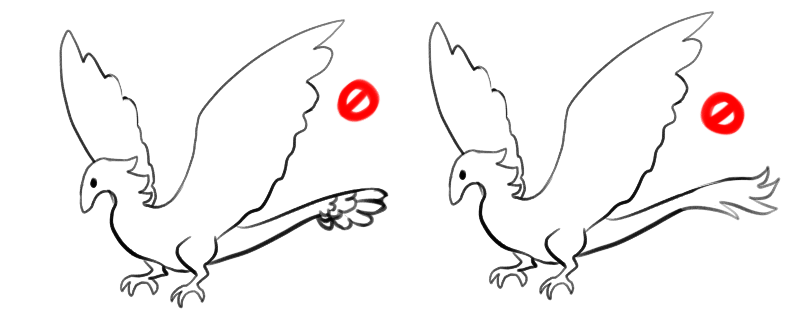
Feather and Fur Tips
The difference between feathers and fur can get very tricky with varying styles. Here is the general rule when drawing feathers. It will have the same flexibility as paper being pulled in the wind. This means paper makes for a very good reference in how feathers bend and fold. Feathers will generally move together and flow in the same direction, with the body. They will not wave in opposite directions or bend in more than one spot.

.
Aquatic Tail
There is no maximum limit on tail length. However, your dragon’s tail must be long enough to be able to touch the ground. Legs will not attach to the tail. When selecting species for a tail reference, do not mix them with other species.
You may use the tail of any water-dwelling species. The tail should only have one fin, and that fin will always be on the end of the tail. At least a small part of the tail will have a bony section—the end fin will not attach directly to the body. If you choose a species that does not live completely in water, then the tail should have specific adaptations to moving through water used in that animal's daily life.
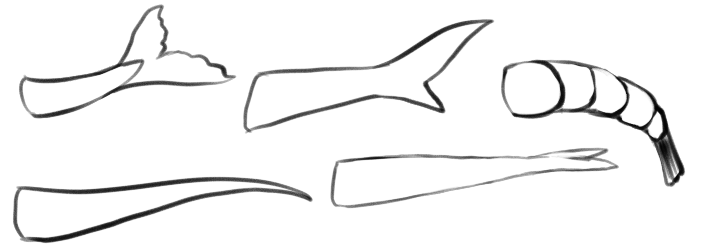
How can I get multiple tails?
The split tail mutation.
Segmented Tail
They resemble the tails of Leopard Geckos, Alligators, Spiny-Tailed Lizards, or similar lizards. You do not have to pick a specific species, as long as it shows the basics of a segmented tail: It has at least one segment that starts off smaller, grows larger, then smaller again. It can be as subtle as a few bumps on the edges of a thick tail.
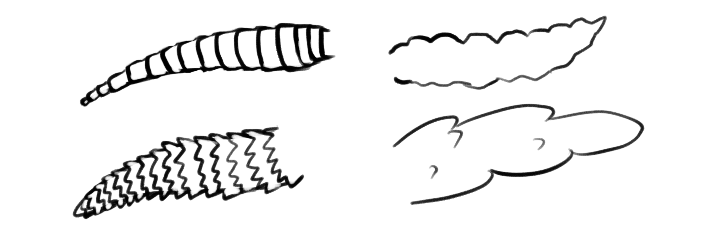
Can I use this to make a scorpion tail?
No, you will need the Insectified trait for that.
How Long Can the Tail Be?
There is no maximum limit on tail length. However, your dragon’s tail must be long enough to be able to touch the ground while standing. Legs will not attach to the tail.
How can I get multiple tails?
The split tail mutation.
Mythic Tail
This allows you to have a free-for-all in how you design your dragon’s tail! It is an incredibly rare trait, with a very low chance of passing down. It may have any of these modifiers for free, as long as they affect the tail: Star Pearl, Iridescence, Bioluminescence, Heraldry, Plating, Spines, Horns, Feathers, Fur, Scales, Spaded Tail, Translucense, Transparency, Miniature, Disassembly, Glitch, Coils, Halo, Display, Protofeathers, Club Tail, Maned, Capricorn, Tentacles, Many-finned, Dorsal Fin, Debris, Split Tail, Bumble, Tailless, Odd Ears, Webbed Tail, Curled, Frilled, Plumes, Extensions, Companion, True Sight, Boneless, Tattered, Engraved, Shimmer, Gilded, Sheen, Armored.
In addition to any of those modifiers, you can get creative. Want to reference extinct species? Go for it! Want to make up your own anatomy? That's an option, too! Want to keep things simple and just give them a wolf tail? Honestly, the options are limitless. Have fun!
Thorned Crest
Horns with one starting point and one ending point. They can be twisted and curved however you like as long as you follow that rule. They should be placed symmetrically along the head and neck. Avoid placing it at the top of the throat so that it doesn't hurt itself (the jawline is alright, though). You may choose the number of horns as long as they do not resemble sharp scales. This will not create fangs or tusks.
The crest should appear somewhere in this range:
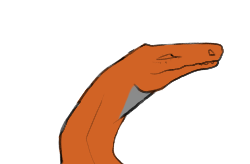
Here are some examples of Thorned Crest:
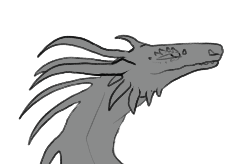
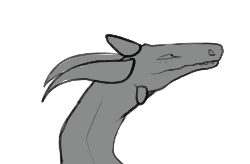


The crest may also be affected by a free gradient of two colors. The free gradient must take from the elemental color palette and/or white, tan, and black. The gradient must start from the point. The colors and gradients will be the same on every horn. The gradient is optional, and you may choose to use a solid color instead. The very ends of the horns may be affected by minimal markings.
Examples of a color vs. a gradient:
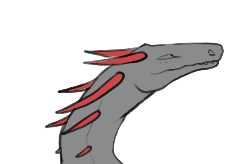
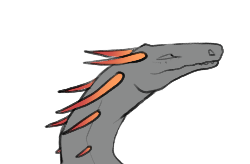
Amphibious Snout
Default to: Jungle, Ocean
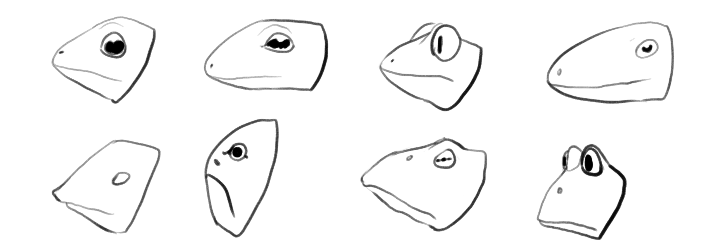
These snouts must reference living, real-world species, though lenience is allowed for simplified styles. Snouts that resemble fully matured amphibians! This typically means frogs, but salamander snouts are also quite common! Only reference living species of amphibians. Please note that horns, ears, fur, barbels, and other protruding traits are excluded when looking at real-world species (unless otherwise stated)! When referring to species, you can’t combine multiple species. When looking for inspiration, only look at species with eyes (unless your dragon has the true sight ability).
Can I have slitted eyes?
Yes! Eye pupils are not tied to snout types. They just need to be natural for any living animal.
Can my dragon have fangs or tusks?
Fangs and tusks should not protrude the distance of the lower jaw (and definitely not hang out) without the Fanged mutation unless otherwise noted. Tiny little nibble fangs are fine. All dragons, regardless of snout type, may have carnivorous-looking teeth.
Aquatic Snout
Default to: Ocean
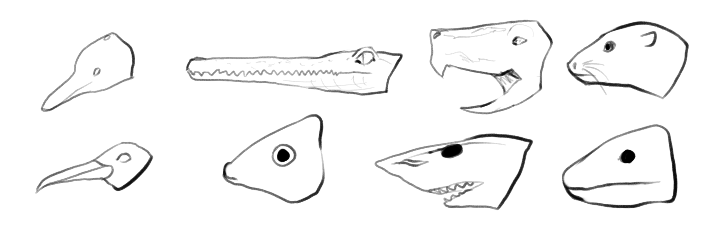
These snouts must reference real-world species, though lenience is allowed for simplified styles. May take from amphibious snouts, aquatic reptilian snouts, or any living sea-dwelling species. If you choose a species that does not live in water, then the snout should have specific adaptations for moving through water that are essential for the creature.
Please note that horns, ears, fur, barbels, and other protruding traits are excluded when looking at real-world species (unless otherwise stated)! Gills are also too far back for them to count as part of the snout. When referring to species, you can’t combine multiple species. When looking for inspiration, only look at species with eyes (unless your dragon has the true sight ability).
Can I have slitted eyes?
Yes! Eye pupils are not tied to snout types. They just need to be natural for any living animal.
Can my dragon have fangs or tusks?
Fangs and tusks should not protrude the distance of the lower jaw (and definitely not hang out) without the Fanged mutation unless otherwise noted. Tiny little nibble fangs are fine. All dragons, regardless of snout type, may have carnivorous-looking teeth.
Artificial Snout
Default to: Thunder
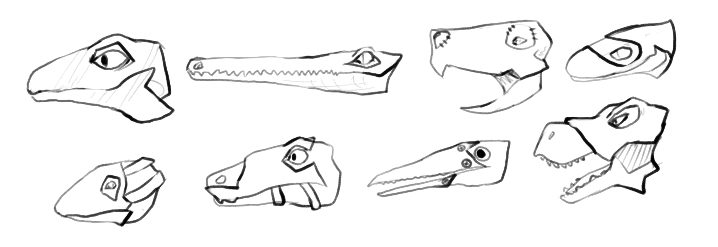
Snouts may be made of metal, clay, bone, or some other artificial or sculpted substance. It covers at least 1/3rd of the underlying face. They can take any shape, but typically serve as a mask rather than a true snout. The eyes will still be visible. If depicted, artificial pieces must cover at least part of the snout. They will not create horns or crests without additional traits. It may blend and connect with other artificial traits, so long as it follows the other rules.
The following list has a few acceptable materials for artificial traits. Their colors must be at 90% opacity or more (see colors for more info on transparency and color). If you do not see something on this list, feel free to ask if it is available!
- Plastic
- Clay
- Metal
- Glass
- Cloth
- Wood
- Bone (note–must be carved/shaped rather than a skeleton on top of the dragon)
All traits must be visibly artificial in order to pass. In example, clay would have a few cracks or flakes, cloth would have something tying it to the rest of the dragon, and metal would have screws on the edges holding them together. You may use up to two materials. Each material must be the same color as all matching materials. In example, if you want to use brown clay as a material, then all other clay must match. Wires, screws, and simple fasteners do not count towards the material limit and may have their own color that matches something else on the dragon. The colors of these extras must still match each other.
Colors
Artificial traits will only have colors natural to their material or colors in the elemental spectrum. For example, a fire dragon cannot be covered in lime green metal. The natural colors of plastics are white and tan. The natural colors of cloth depend on the material used to make them; For that, stick to plant materials in our known universe. Cloth traits cannot be dyed without the Scalestain item. Glass will always be tinted white or an elemental color. Clay will take on white, gray, light steel blue, red, orange, brown, or tan colors, similar to the ones seen in the Earth palette.
As elemental creatures, the magic of your dragon may also color its features their corresponding elemental color, even if it is outside of that material’s natural range. In this situation, it will only be one or the other (a red clay + blue ocean element color can’t equal purple). The reason that glass will never be fully transparent is because of this ‘leaking’ magic effect.
Artificial traits may have a sheen/shine if it’s a material that naturally does that.
Display Traits
Similarly to color, a dragon’s display traits will always show, even if they need to leak through the artificial materials. Accents are included in this, allowing some areas of the snout to take on colors that might not match the material it's made of. While you can have artificial materials cover traits, they must still be apparent somewhere on the dragon. In example, if your dragon has Zebra, you may limit its stripes to the face and legs if your dragon’s body is covered in artificial scales. When the artificial parts are removed, you may have markings appear underneath, or simply leave that area blank.
What’s Underneath
The purpose of artificial traits is typically to aid in the health of the dragon. No dragon is born with their artificial traits included–their Rider, a passerby, or they themselves will construct something for them. Here are some reasons that a dragon may need an artificial snout: Misaligned jaw, exposed flesh, sensitive snout.
With that in mind, the traits underneath resemble traits you can see in other dragons. When your dragon has their artificial parts off, they will resemble a malformed version of a parent’s trait (with the exception of mythical traits, which will only produce a default option) or a monstrous snout (although this monstrous snout will always have eyes unless true sight is present).
A Matter of Pride
Of course, there are many reasons that a dragon may not need artificial traits at all. There are crestless dragons that live their life just fine, wyrms that have no need of legs, and wingless critters that are content with their position on the ground. For dragons on the healthier scale of things--especially those of the Thunder element--artificial traits are a way to boost their confidence and have traits they believe is required for them, regardless of whether or not they really need that giant crown-shaped crest.
Going Without
Similar to healthy dragons which insist on their custom artificial traits, there may be some dragons with health issues that choose to go without. These dragons may choose to only partially cover their scales, replace only a single limb and leave the others mismatched, or even go without an aid entirely. If your dragon goes without, its design must follow the ‘What’s Underneath’ section above.
Can I have slitted eyes?
Yes! Eye pupils are not tied to snout types. They just need to be natural for any living animal.
Can my dragon have fangs or tusks?
Fangs and tusks should not protrude the distance of the lower jaw (and definitely not hang out) without the Fanged mutation unless otherwise noted. Tiny little nibble fangs are fine. All dragons, regardless of snout type, may have carnivorous-looking teeth.
Fruit Snout
Default to: Storm
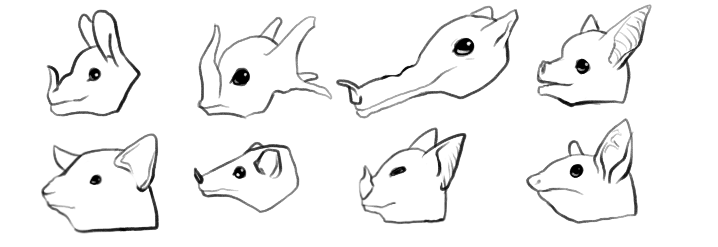
Flat snouts resembling that of a bat! These snouts must reference living real-world species, though lenience is allowed for simplified styles. It should be from the true family of bats. You can choose any single species of bat to base your snout on. You are free to include strange noses and ears, so long as it matches the species you choose. When referring to species, you can’t combine multiple species. When looking for inspiration, only look at species with eyes (unless your dragon has the true sight ability or a monstrous snout).
Can I have slitted eyes?
Yes! Eye pupils are not tied to snout types. They just need to be natural for any living animal.
Can my dragon have fangs or tusks?
Fangs and tusks should not protrude the distance of the lower jaw (and definitely not hang out) without the Fanged mutation unless otherwise noted. Tiny little nibble fangs are fine. All dragons, regardless of snout type, may have carnivorous-looking teeth.
Reptilian Snout
Default to: Fire, Earth
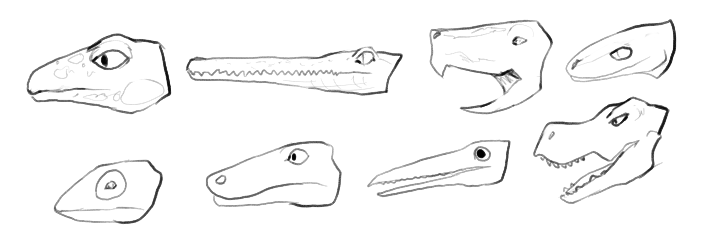
The typical dragon snout! These snouts must reference real-world species, though lenience is allowed for simplified styles. You may reference any non-avian reptile for this. This includes extinct species. When referring to species, you can’t combine multiple species. When looking for inspiration, only look at species with eyes (unless your dragon has the true sight ability).
Can my dragon have fangs or tusks?
Fangs and tusks should not protrude the distance of the lower jaw (and definitely not hang out) without the Fanged mutation unless otherwise noted. Tiny little nibble fangs are fine. All dragons, regardless of snout type, may have carnivorous-looking teeth.
Theropod Snout
Default to: Wind
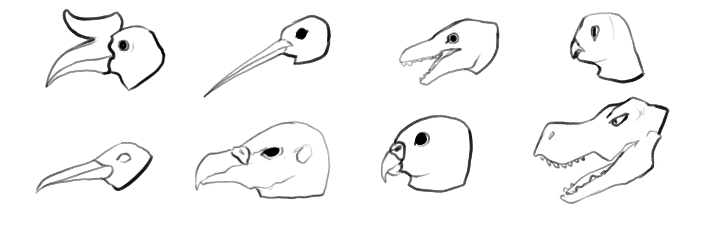
The dragon’s head takes the shape of any theropod dinosaur (which does include avians, if you desire a beaked dragon). You may include strange beaks if your chosen species has it; However, any horns, spines, feathers, or other crests should not be included unless it is part of the beak. You may reference extinct species. You can’t combine multiple species. When looking for inspiration, only look at species with eyes (unless your dragon has the true sight ability).
Color
The beak of a dragon may be treated like bone. You may use any elemental color, plus black, white, or desaturated browns and tans. Additionally, any area affected by Accents may follow the color rules of Accents, including beaks. Lastly, if you are referencing a species with distinct ceres (such as Parakeets or Pigeons), then the cere may be any color.
Can I have slitted eyes with non-reptilian snouts?
Yes! Eye pupils are not tied to snout types. They just need to be natural for any living animal.
Can my dragon have fangs or tusks?
Fangs and tusks should not protrude the distance of the lower jaw (and definitely not hang out) without the Fanged mutation unless otherwise noted. Tiny little nibble fangs are fine. All dragons, regardless of snout type, may have carnivorous-looking teeth.
Scrounge Snout
Default to: Metal
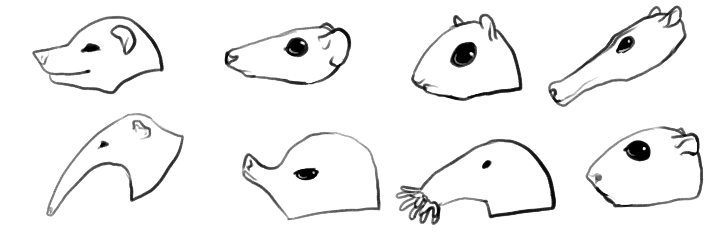
Snouts designed for digging through substrate and finding small creatures. Their sensitive noses can detect slight electromagnetic fields that their prey exhibits.
Shape
You may reference opossums, moles, rodents, pangolins, anteaters, and the mammal order Eulipotyphla. If referencing a species, ears must have realistic proportions compared to the species referenced. Stylized ears that are too large will be pinged. If you are not referencing a species, ears should be very small or nonexistent, as in the above examples. You are free to include strange nose shapes if they match the species.
These are one of the most versatile type of snout, but they do have a very defining feature. Their brow will always be very concave or convex. A snout will never be both--it may only have one curve direction (though, it can be dramatic enough to loop around!) There may be a small area towards the snout that sharply flattens. For nostrils, you may use lizard-like nostrils or small mouse-like nostrils. If you do choose to refer to specific species for oddities like a star-shaped nose, you can’t combine multiple species, and it must look like that species. When looking for inspiration, only look at species with eyes (unless your dragon has the true sight ability).
Examples without a Specific Species Reference:

The left three all have dramatic concave or convex brows. The one on the right does not pass, as the brow is flat and not dynamic, AND it does not reference a species listed above.
Can scrounge snout have rabbit ears?
No, they are too large. The examples at the top of the page show how large Scrounge Snout ears are allowed to be.
Can I have slitted eyes with non-reptilian snouts?
Yes! Eye pupils are not tied to snout types.
Can my dragon have a flat brow/normal-looking brow if I reference a species?
Yes, as long as it's a species from opossums, moles, rodents, pangolins, anteaters, and the mammal order Eulipotyphla.
Can my dragon have fangs or tusks?
Fangs and tusks should not protrude the distance of the lower jaw (and definitely not hang out) without the Fanged mutation unless otherwise noted. Tiny little nibble fangs are fine. All dragons, regardless of snout type, may have carnivorous-looking teeth.
Monstrous Snout
Default to: Dark
Monstrous Snout is a type of deteriorating face common to Dark dragons and--should they lack prosthetics--Thunder dragons. It can be as minimal as two large, malformed teeth (fangs!) or as extreme as odd mouth shapes and melting scales. Simple plating on the top or bottom of the dragon's snout also works.

You can use just about any shape, with one caveat–it must also be deteriorating in some way. This can be bones or flesh showing, unnatural mouth shapes, a mask of bone, more or less eyes than the normal two, or even turning into mist or goop. For minimal expression, a pair of fangs is enough (as seen on the second example above). Ears may be as large as a lion’s, in any shape (avoid stylizing this to be larger!). This snout may have small fangs, tusks, and bony material without the corresponding mutation. It may have between 0-4 eyes placed anywhere on the snout. When eyes are missing, you may choose whether or not there are sockets left behind. If the mouth is hard to see, then a reference must be provided in the Design Notes of your design submission.
Shape
When using stylized mouth shapes, the abnormal teeth should be apparent. The first example has consistent teeth shapes, while the latter two have noticeable fangs.
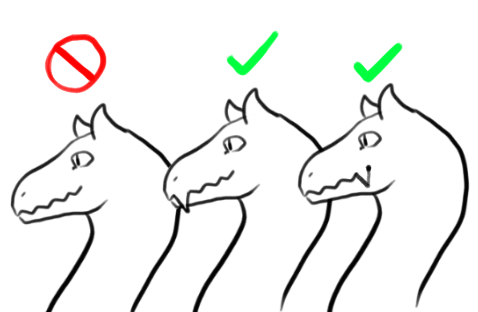
The dragon will never be actively bleeding, even if there is missing skin or scarring.
Can monstrous snout have cat ears?
Domestic cat ears are very large, so they are not allowed. The largest ears allowed are lion-like ears. Apophis is a good example of the largest ears allowed. Other types of ears are allowed as long as they are within the size range, resemble ears, and appear on the sides of the head as one or a symmetrical two ears.
Range
Monstrous effects such as bones, misplaced eyes, misplaced mouthparts, and so on may extend to the neck. It will not go further than the shoulders and/or collarbone.
Color Rules
- Bones and spines follow regular Bone Color rules.
- Flesh may be any color, though it must be consistent with any other visible flesh.
- Melting areas will always match the color of the melting area. It may have minimal sheen and transparency in areas it has dripped off of the body--these effects must very subtle!
- Only skin, spines, plates, and ear tips may have accents. Flesh and regular bone will not have accents.
- Traits similar to Monstrous effects may stack. In example, a dragon with a Fanged trait does not need to do anything extra for the snout to count as Monstrous. The same applies to Plating, Aegis, Transparent Skin, True Sight (other than color-changing), and other effects that resemble monstrous effects--as long as they appear somewhere on the snout.
Mythic Snout
This allows you to have a free-for-all in how you design your dragon’s face! It is an incredibly rare trait, with a very low chance of passing down. It may have any of these modifiers for free, as long as they are in the snout and neck region: Iridescence, Bioluminescence, Bearded, Translucent, Insectified, Floral Parasite, Frog Throat, Antennae, Miniature, Odd Ears, Disassembly, Glitch, Coils, Halo, Display, Whiskers, Neckfrill, Fanged, Protofeathers, Maned, Tentacles, Many-finned, Gilled, Bumble, Curled, Frilled, Plumes, Beaked, Extensions, Companion, Transparent Skin, True Sight, Boneless, Tattered, Engraved, Shimmer, Gilded, Sheen, Armored, Plated Spine.
In addition to any of those modifiers, you can get creative. Want to reference extinct species? Go for it! Want to make up your own anatomy? That's an option, too! Want to keep things simple and just give them a wolf snout? Honestly, the options are limitless. Have fun!
No Crest
This is pretty self-explanatory. The dragon has no extra horns, spines, or fins as a crest.
Crowned Crest
Multi-pronged horns (antlers). They must have branches of some kind. While one or two prongs may be 'misaligned,' it should be roughly symmetrical. The ends do not need to be sharp, but they do need to be easily visible as different 'points.' This will not create fangs or tusks. The origin point of the crest must start in the colored area below:

Various Examples of Crowned Crest:

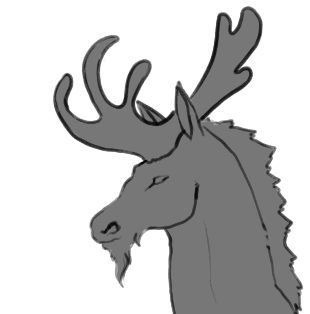

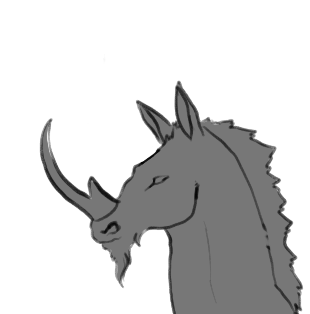
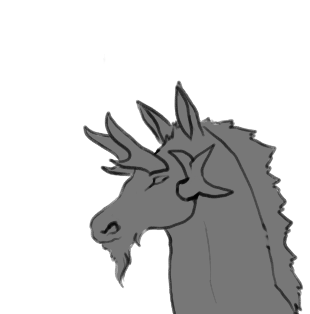
The crest may also be affected by a free gradient of two colors. The free gradient must take from the elemental color palette and/or white, tan, and black. The gradient may radiate from the prongs or affect the crest as a whole. The color and/or gradient will be the same on every horn. The gradient is optional, and you may choose to use a solid color instead. The very ends of the horns may be affected by minimal markings.
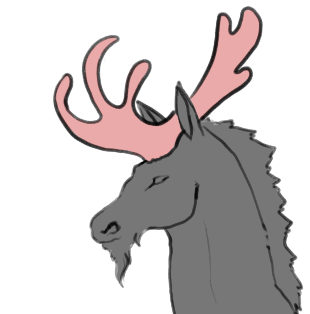
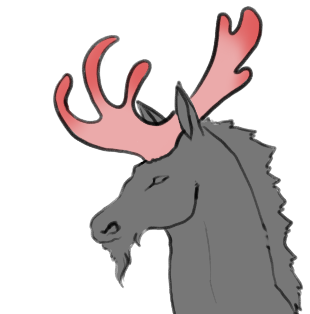
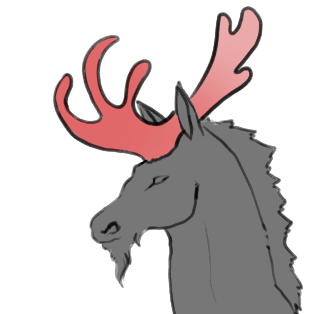
Spined Crest
Porcupine-like spines on the head and neck. They should be thin and must contain at least three spines. Patches of spines should be roughly symmetrical. While they can bunch into regions, the individual spines should be apparent. It will not create a hair-like mane, fangs, or tusks. It can be anywhere except the throat of the dragon (the jawline is a-okay, though--just make sure your dragon can look down without stabbing itself on accident!).
The crest should appear somewhere in this range:

Here are some examples of Spined Crest:
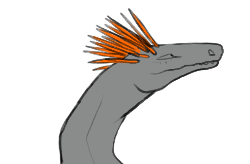
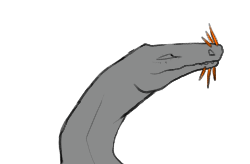
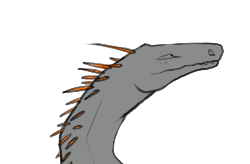
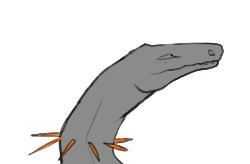
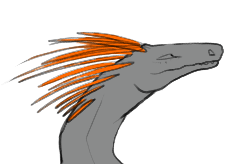
The crest may also be affected by a free gradient. The free gradient must take from the elemental color palette and/or white, tan, and black. The gradient must start from the point. The colors and gradients will be the same on every horn, with a bit of leeway given for spines that are dramatically different sizes. The gradient is optional, and you may choose to use a solid color instead. The very ends of the horns may be affected by minimal markings. Here is a gradient example:
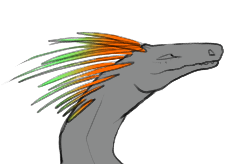
Ungulate Snout
Default to: Light
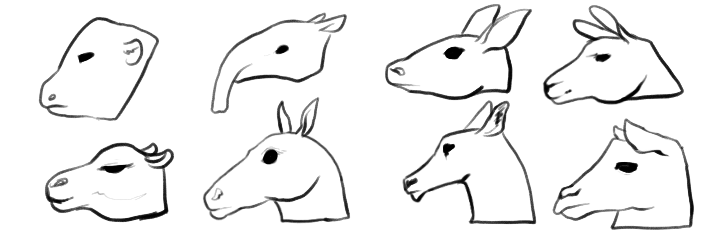
The base for kirin snouts. You may choose any member of the ungulate family to reference for a snout except for the Whippomorpha clade. This means that horses, mules, antelope, bison, buffalo, llamas, and tapirs are fair game…but hippopotamuses and whales are out of the question. You may include a SHORT mane that resembles that of wild zebras. This mane should not go past the neck of the dragon. You may include ears which match the species you chose. Avoid making them stylistically larger than they appear on the species you reference.
Please note that horns, fur, barbels, and other protruding traits are excluded when looking at real-world species (unless otherwise stated)! Ears must have realistic proportions compared to the species referenced. Stylized ears that are too large will be pinged. When referring to species, you can’t combine multiple species. When looking for inspiration, only look at species with eyes (unless your dragon has the true sight ability).
Can I have slitted eyes?
Yes! Eye pupils are not tied to snout types. They just need to be natural for any living animal.
Can my dragon have fangs or tusks?
Fangs and tusks should not protrude the distance of the lower jaw (and definitely not hang out) without the Fanged mutation unless otherwise noted. Tiny little nibble fangs are fine. All dragons, regardless of snout type, may have carnivorous-looking teeth.
Finned Crest
This crest takes inspiration from fish. No matter what, this crest will either be centered or symmetrical. It may do one of these:
- create up to two lures/barbels/spines/humps
- create fins on the side of the head and/or down the neck
Lures/barbels/spines/humps will not glow. They must resemble structures on existing fish. Here are some examples of this style:
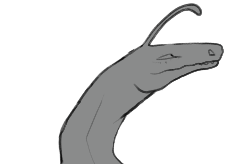
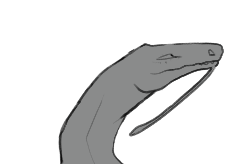
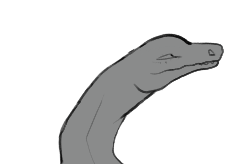
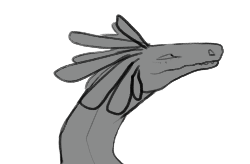
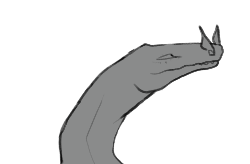
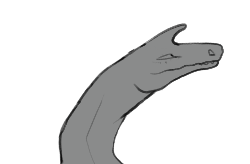
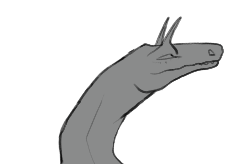
Gradients for this style will contain two colors in the elemental palette. If using a gradient, it will radiate from the end of the crest (or center, if using a hump). The very tip may be affected by minimal markings.
Finned styles may resemble the fins of any living fish. It may have one fin down the center of the neck, two fins on the side, or both.
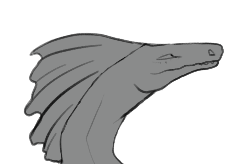
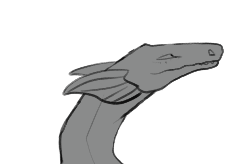
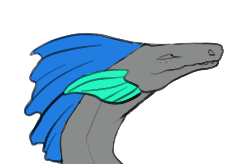
Gradients can affect the center fin and side fins differently, but they will both use the same color, and the side fins will be symmetrical. Here are some examples of these free colors:
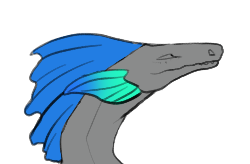
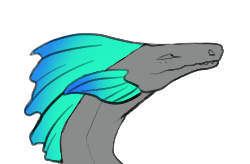
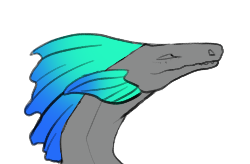
Feathered Crest
A head of feathers that can resemble any real-world bird crest or simply a bunch of feathers looking pretty. The crest should appear somewhere in this range. The base of the jaw and top of the neck are not allowed. However, you may use the jawline and cheeks themselves! The feathers will never create a mane-like structure--it should be a focal point starting near the head!

Here are some examples of Feathered Crests:
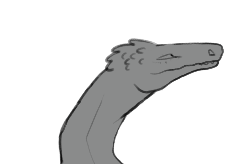
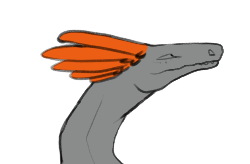
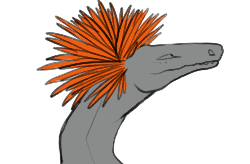
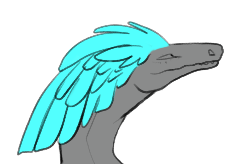
Crests may take on a gradient from the furthest extreme or from the top feathers to the bottom feathers.

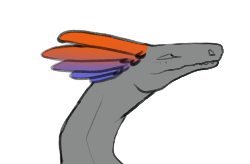
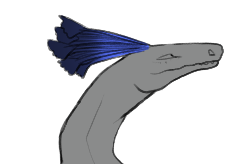
Minimum marks may affect the very tips of the mark.
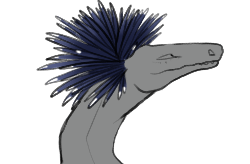
The top layer of feathers may be the same color as the base.
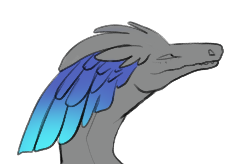
Artificial Crest
Default to: Thunder
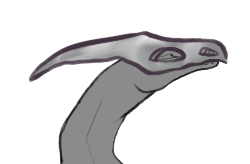
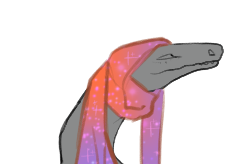
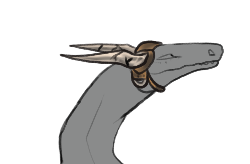
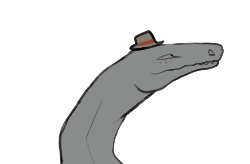
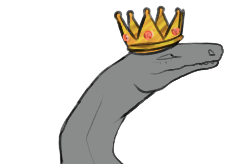
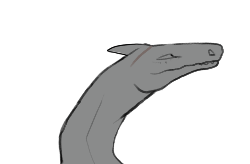
Crests may be made of metal, clay, bone, or some other artificial or sculpted substance. They can take any shape as long as they look artificial. The eyes will still be visible. If depicted, artificial pieces must cover at least part of the head. It may blend and connect with other artificial traits, so long as it follows the other rules.
The following list has a few acceptable materials for artificial traits. Their colors must be at 90% opacity or more (see colors for more info on transparency and color). If you do not see something on this list, feel free to ask if it is available!
- Plastic
- Clay
- Metal
- Glass
- Cloth
- Wood
- Bone
Additionally, artificial crests are allowed some decorative materials that do not contribute to the total:
- Chains
- Strings
- Jewels
All traits must be visibly artificial in order to pass. In example, clay would have a few cracks or flakes, cloth would have something tying it to the rest of the dragon, and metal would have screws on the edges holding them together. You may use up to two materials. Each material must be the same color as all matching materials. In example, if you want to use brown clay as a material, then all other clay must match. Wires, screws, and simple fasteners do not count towards the material limit and may have their own color that matches something else on the dragon. The colors of these extras must still match each other.
Colors
Artificial traits will only have colors natural to their material or colors in the elemental spectrum. For example, a fire dragon cannot be covered in lime green metal. The natural colors of plastics are white and tan. The natural colors of cloth depend on the material used to make them; For that, stick to plant materials in our known universe. Cloth traits cannot be dyed without the Scalestain item. Glass will always be tinted white or an elemental color. Clay will take on white, gray, light steel blue, red, orange, brown, or tan colors, similar to the ones seen in the Earth palette.
As elemental creatures, the magic of your dragon may also color its features their corresponding elemental color, even if it is outside of that material’s natural range. In this situation, it will only be one or the other (a red clay + blue ocean element color can’t equal a pure purple metal). The reason that glass will never be fully transparent is because of this ‘leaking’ magic effect.
Artificial traits may have a sheen/shine if it’s a material that naturally does that. If you use a gradient, it will be consistent across each material, and start from the extremities.
Display Traits
Similarly to color, a dragon’s display traits will always show, even if they need to leak through the artificial materials. While you can have artificial materials cover traits, they must still be apparent somewhere on the dragon. In example, if your dragon has Zebra, you may limit its stripes to the face and legs if your dragon’s body is covered in artificial scales. When the artificial parts are removed, you may have markings appear underneath, or simply leave that area blank.
What’s Underneath
The purpose of artificial traits is typically to aid in the health of the dragon. No dragon is born with their artificial traits included–their Rider, a passerby, or they themselves will construct something for them. Here are some reasons that a dragon may need an artificial snout: Misaligned jaw, exposed flesh, sensitive snout. With that in mind, the traits underneath resemble traits you can see in other dragons. When your dragon has their artificial parts off, they will resemble a malformed version of a parent’s trait (with the exception of mythical traits, which will only produce a default option) or simply no crest.
A Matter of Pride
Of course, there are many reasons that a dragon may not need artificial traits at all. There are crestless dragons that live their life just fine, wyrms that have no need of legs, and wingless critters that are content with their position on the ground. For dragons on the healthier scale of things--especially those of the Thunder element--artificial traits are a way to boost their confidence and have traits they believe is required for them, regardless of whether or not they really need that giant crown-shaped crest. Which, speaking of, is what a lot of artificial crests look like. Unlike other artificial traits, crests may be decorative and abstract in nature, so long as they appear artificially created. There is also no need to create monstrous effects if dragons choose to go without an Artificial Crest.
Going Without
Similar to healthy dragons which insist on their custom artificial traits, there may be some dragons with health issues that choose to go without. These dragons may choose to only partially cover their scales, replace only a single limb and leave the others mismatched, or even go without an aid entirely. If your dragon goes without, its design must follow the ‘What’s Underneath’ section above.
Saurian Crest
Takes inspiration from non-feathered crests of reptiles in general (not necessarily dinosaurs). Parasaurolophus, Carnotaurus, and Nyctosaurus are just a few examples of acceptable Saurian crests. It should have a noticeable real-world equivalent with similar shapes and proportions. Since a lot of dinosaur restorations are speculative, a bit of leeway is given for unusual crests (in example: whether some crests had membranes or not). It must appear somewhere on the head or upper neck. This will not touch the base of the neck or create expanding flaps or air sacks. Here are some examples of acceptable saurian crests:
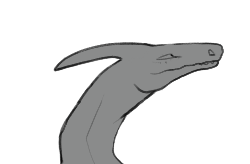
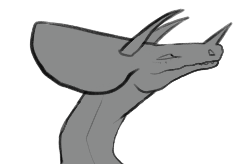
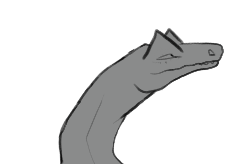
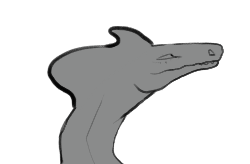
Because these traits exhibit a lot of diversity, the free gradient/coloration can appear in many forms. Flesh, webbing, and horns may take on their own free gradient of two colors or a solid color. Webbing and flesh will use colors from the elemental color palette. Horns use the palette in addition to black, white, or tan. Gradients will radiate either from extremes or down the lining of the webbing. Here is an example of the same crest, colored in two different ways, both showing the bone with a unique color:
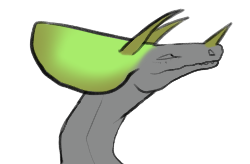
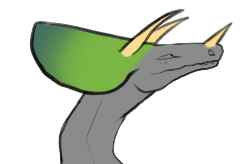
Here is an example with the flesh showing a gradient and the webbing showing a different gradient:
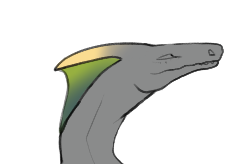
Here are more general examples:
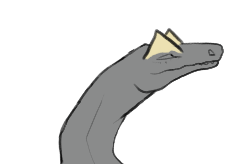
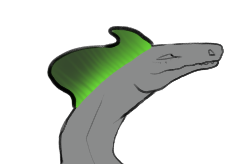
The world of Saurian Crests is huge. If you want some ideas to bounce off of, here are some creatures with acceptable Saurian Crests: Pterosaurs, Ceratopsians, Carnotaurus, Pachycephalosaurs, crested Hadrosaurs, and even Plumed Basilisks. Avoid using overly speculative crest interpretations.
Mythic Crest
This allows you a free-for-all in how to design your dragon's crest! This will not change the shape of the face itself, but may add on protrusions. You may add any of these traits to your dragon for free, as long as they affect the crest area:
Feathers, Plating, Scales, Fur, Double Crest (or more), Translucence, Horns, Spines, Antennae, Floating Pieces, Glitching, Wires, Halos, Display, Whiskers, Neckfrill, Maned, Tentacles, Fins, Debris, Odd Ears, Frilled, Plumes, Extensions, Companion (note: this will not give an extra snout and must affect the crest), Tattered, Engraved, Shimmer, Gilded, Sheen, Armored
In addition to any of those modifiers, you can get creative. Want to reference extinct species? Go for it! Want to make up your own anatomy? That's an option, too! Want to keep things simple and just give them a unicorn horn? Honestly, the options are limitless. Have fun!
Quadrupedal Body
A dragon that stands on four legs. No matter the shape of its legs, its center of gravity should be near the belly or chest. It should not be overly long, as that would resemble the Wyrm body type. Here are two examples--one with and without wings. The dark area shows the amount required for a dragon to gain lined and shaded exp. The whole colored area shows the amount required for fullbody and background exp, as well as activity rolls. Note that the range for winged and wingless varies slightly!
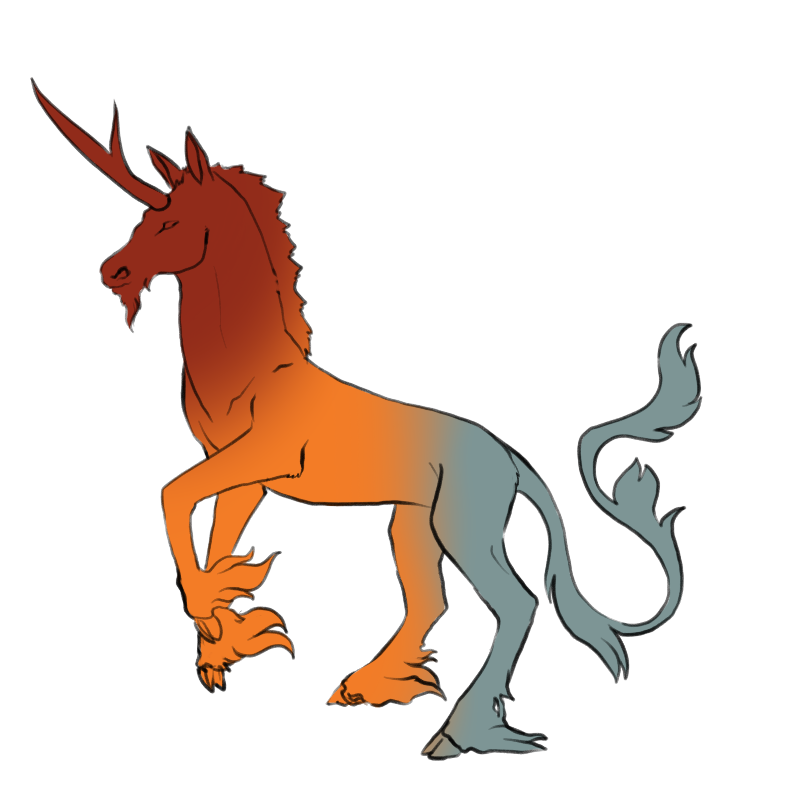
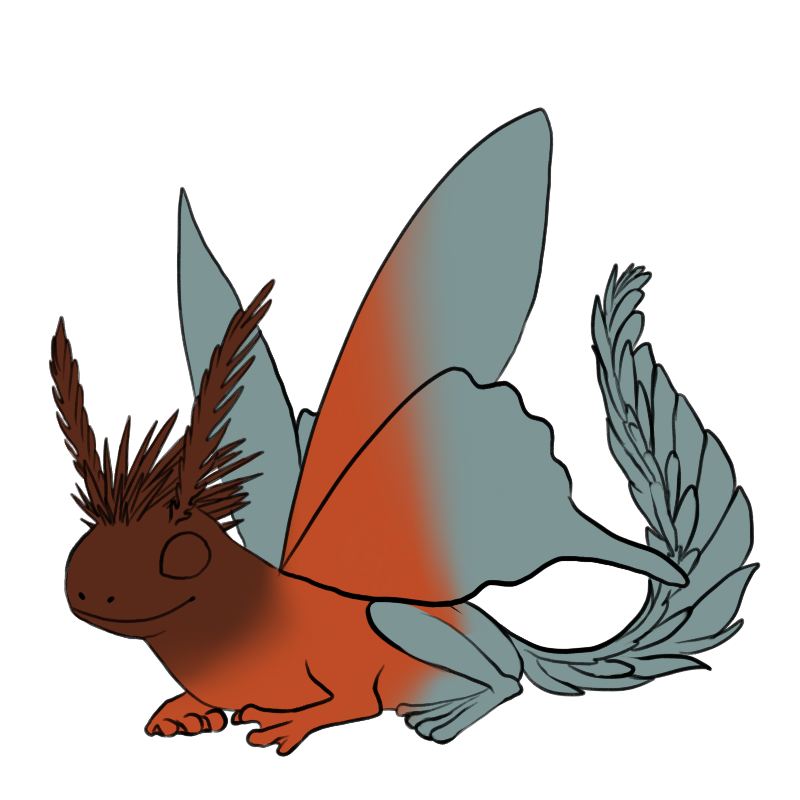
Bipedal Body
A dragon that stands on two legs and has a set of arms. Its center of mass while running should be between its thighs. It may rest on all fours when not in motion. Some dragons have longer front legs that they pull up when they are running, and are thus bipedal. These front legs are not adapted for walking and will end in sharp digging claws that prevent running on them. The dark area shows the amount required for a dragon to gain lined and shaded exp. The whole colored area shows the amount required for fullbody and background exp, as well as activity rolls. Note that the range for winged and wingless varies slightly!
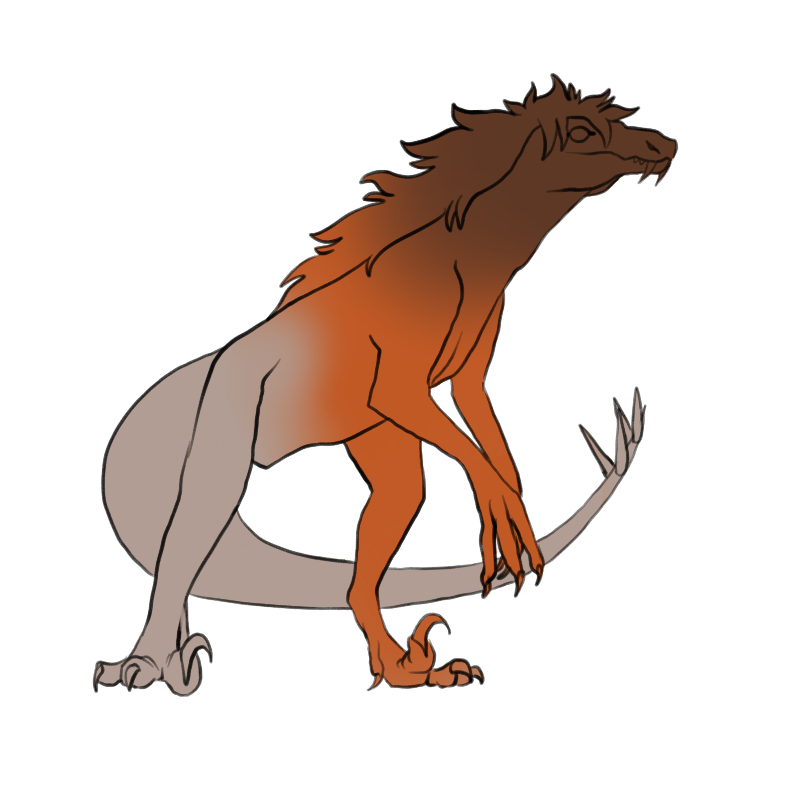
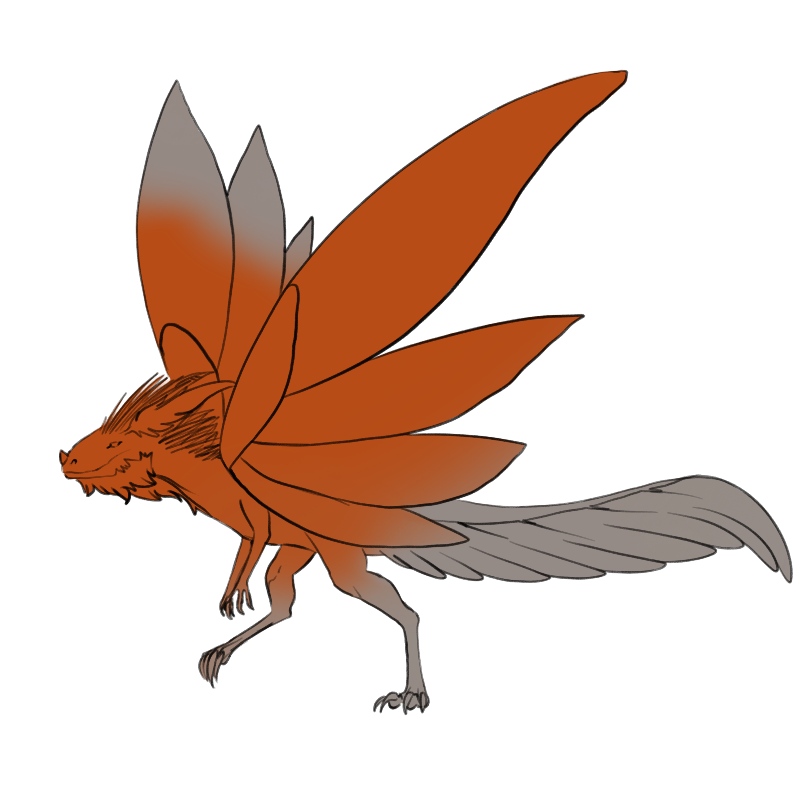
Wyvern Body
A dragon that stands on two legs and has no forelimbs (other than wings). A Wyvern that is also wingless is a sorry sight indeed. Winged wyverns sometimes walk with their wings to support them, similar to pterodactyls and bats. Red represents minimum coverage to gain colored/shaded exp, while the colored area represents the minimum for activities. The range is the same both for wingless and winged wyverns.
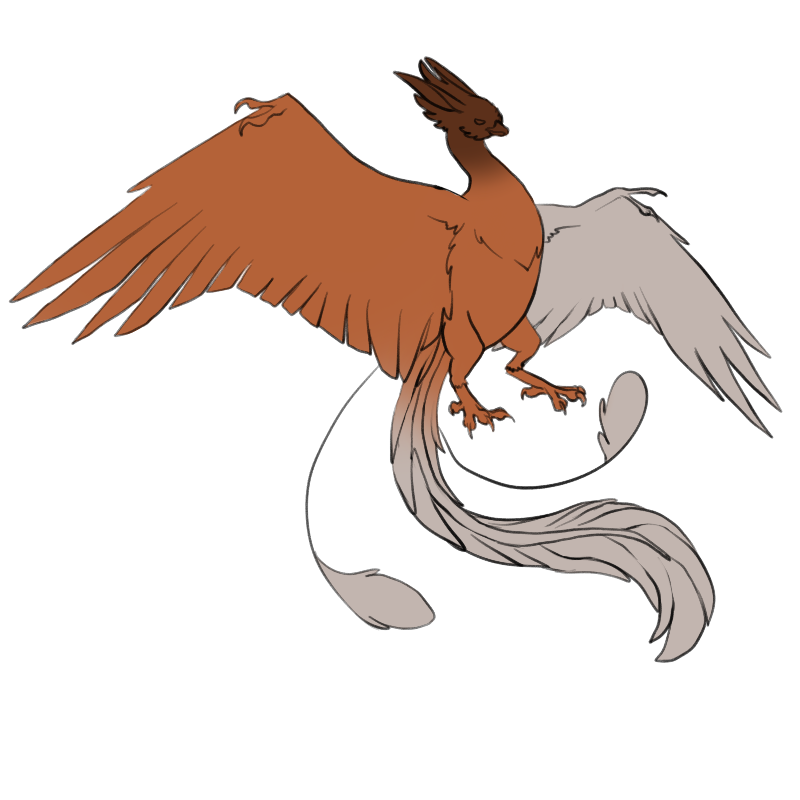
Wyrm Body
A long and noodle-y dragon. May have zero, two, or four limbs of the same size; they should be proportionately small and/or distant from each other compared to the length of the body. Wyrm dragons may participate in Rite of Ascension without using an Ascension Elixir, even if they do not have wings. The color shows the amount required for full body credit. Note that winged and wingless dragons have a different minimum!


How long does a wyrm have to be?
The example below is a dragon that could count as either Quadrupedal or Wyrm. The body section of a Wyrm should appear this long or longer. Tail length does not contribute to how stretched-out a wyrm needs to be.
Monstrous Body
Just…what is this dragon? Its body is unable to maintain a solid shape. It can resemble any body shape, but will clearly be melting or deteriorating in some fashion. Here are the options you can choose from (or pick all) to show that your dragon has a monstrous body:
- Melting
- Evaporating
- Bones/flesh sticking out
It can have between zero to four legs…but this does not need to be an even number, or even symmetrical. When melting or deteriorating, it will always move in the same direction. It will not create localized cloudy feathering, oozing manes, or so on (unless those traits are on the dragon’s genes).
Since the number of legs and length varies dramatically for these dragons, reference the nearest body type to your design to find out what coverage is needed for this dragon to gain EXP or activity rolls.
Avoid creating long trails of melting or evaporating material. Deterioration fizzles out very quickly, so adding long-lasting effects like that require magic. When adding bone structures, they should resemble bones that would naturally be in the area. In example, you can put a spine-like set of bones on the back, but not on the legs. Plating still needs the appropriate trait before it can be used as a monstrous effect.
Color Rules
- Bones and spines follow regular Bone Color rules.
- Flesh may be any color, though it must be consistent with any other visible flesh.
- Melting areas will always match the color of the melting area. It may have minimal sheen and transparency in areas it has dripped off of the body--these effects must very subtle!
- Only skin, spines, plates, and ear tips may have accents. Flesh and regular bone will not have accents.
- Traits similar to Monstrous effects may stack. In example, a dragon with a Thorned Spine trait does not need to do anything extra for the snout to count as Monstrous. The same applies to Plating, Aegis, Transparent Skin, Dorsal Spines, Shell, True Sight (if it is somewhere on the body), Beaked, Shell, and other effects that resemble monstrous effects--as long as they appear somewhere on the body.
Mythic Body
This allows you to have a free-for-all in how you design your dragon’s body! It allows you to choose the placement of wings, snout, limbs, and tail (if they have them). It may have up to four wings, one snout, four limbs, and one tail.
It is an incredibly rare trait, with a very low chance of passing down. It may have any of these modifiers for free, as long as they affecting the main body, rather than extremities: Iridescence, Bioluminescence, Heraldry, Plated Underbelly, Plated Spine, Thorned Spine, Translucent, Dorsal Spines, Frog Throat, Miniature, Disassembly, Glitch, Coils, Display, Neckfrill, Tentacles, Capricorn, Many-finned, Pelvic Spines, Dorsal Fin, Gilled, Debris, Bumble, Odd Ears, Curled, Frilled, Plumes, Extensions, Companion, Multi-limbed, Transparent Skin, True Sight, Boneless, Tattered, Engraved, Shimmer, Gilded, Sheen, Armored.
In addition to any of those modifiers, you can get creative. Want to reference extinct species? Go for it! Want to make up your own anatomy? That's an option, too! Want to keep things simple and just give them an extra pair of wings? Honestly, the options are limitless. Have fun!
